The post Maximón: Guatemala’s Chain-Smoking Savior appeared first on The Expeditioner Travel Site.
]]>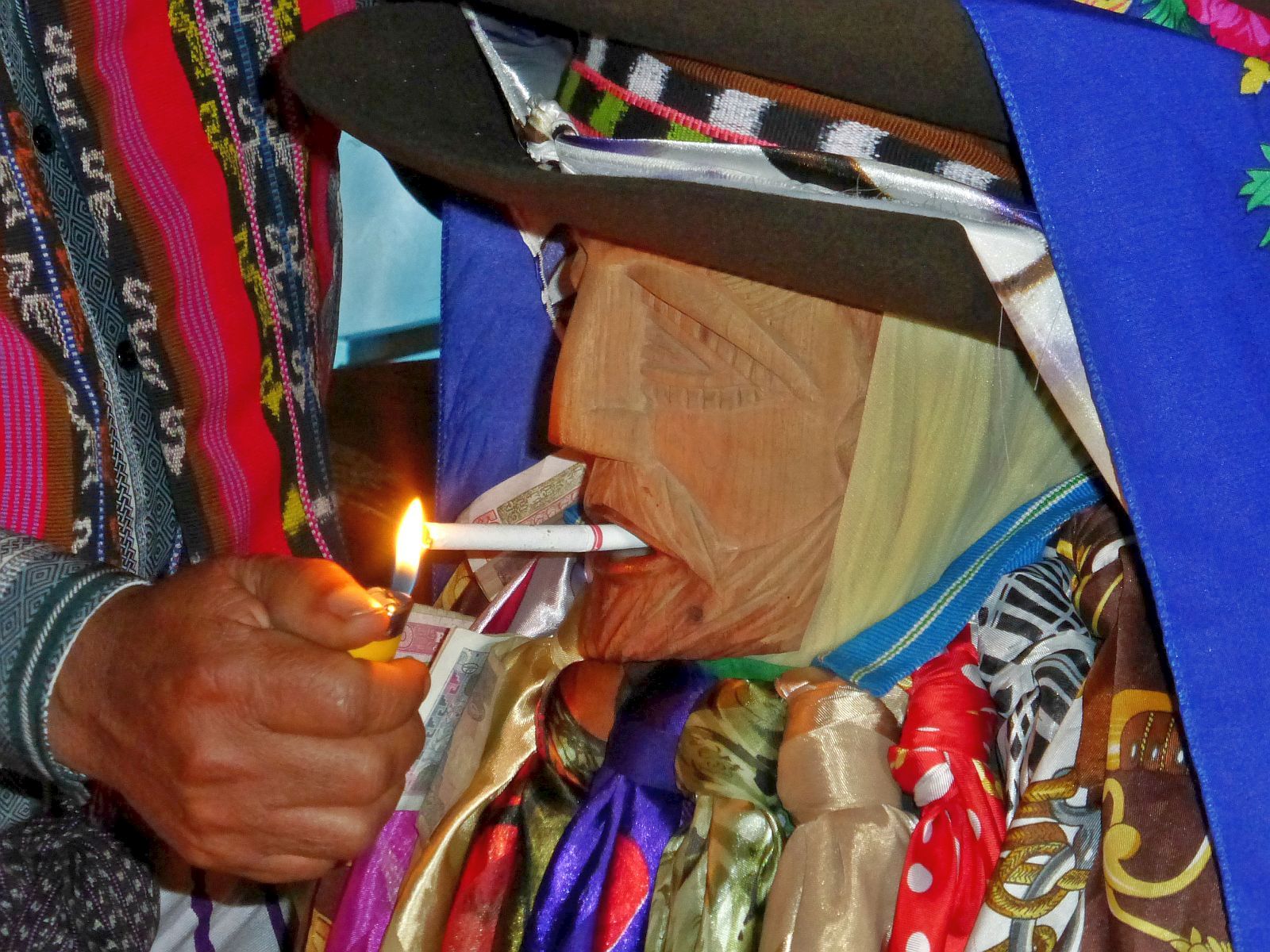
Floating mosaics of water lilies hug the sunken interiors of old buildings that line both sides of the dock. I sigh while staring at the jagged cement tops that barely pop above the surface. Water levels here have been rising steadily over the past 50 years.
“There used to be a huge park here . . .” the boat driver laments.
In many ways, Maximón — the vice-laden trickster deity of the Guatemalan highlands — is like these buildings. His foundations are visible yet submerged, planted below the surface yet reaching above. Like much in Latin America, he’s a mix of Spanish and Indigenous influences; a combination of San Simon from the Catholic tradition and earlier Mayan deities. To many of the Maya in Guatemala he’s known as Rilaj Maam.
Although his origins lie in the murky depths, legend states that Maximón was quite a Casanova back in the mythopoetic day. One day, while the men were off farming, he seduced all their wives. Upon returning, the angry farmers chopped off both his arms and legs. However, life hasn’t been that bad for the legless/armless deity.
Today you can find Maximón in many places throughout Guatemala, but Santiago Atitlán is the most famous. There you can see him draped in a garland of clip-on ties with a wide-brimmed hat dangling with silk as he’s offered gifts of Rubios cigarettes, bottles of Quetzalteca and money, in exchange for help in areas of business, marriage, crops, health, death and more.
On a cloudy afternoon during Guatemala’s rainy season, Sue, my travel companion, and I set out to find this notoriously dubious deity. There is something deeply appealing about a saint who can knock back a few shots of Quetzalteca — the harsh local hooch named after the national bird — and then dole out wisdom to those in need. He felt approachable.
We crouch onto the simple wooden benches of a water taxi, or lancha, at an empty dock in Panajachel and head off. It’s 30 minutes to Santiago Atitlán.
This city in the highlands is nestled between three volcanoes (Tolimán, Atitlán and San Pedro) and faces a lake Aldous Huxley famously called “the most beautiful in the world”: Lago de Atitlán. At 50,000 people, it’s the largest of the lakeside communities in Lake Atitlán.
Most of the local women wear purple-striped skirts and huipiles with floral designs and the older men are known for their white-striped pants. It’s an artistic hub popular for its Tz’utujil oil paintings — vibrant canvases that often depict a bird’s-eye view of rural scenes and landscapes.
Long before the arrival of the Spanish, the Tz’utujil Maya called this place Chuitinamit. It was their capital. To this day it still holds the largest population of Tz’utujil Maya in all of Guatemala. In 1547, in an effort to consolidate indigenous populations, Franciscan friars changed the name and established the town of Santiago.
At the height of the civil war in the 1980s, the Guatemalan army cracked down on the left-wing guerrilla presence here by killing and causing the “disappearance” of hundreds of villagers. A brutal massacre in 1990 saw 13 Tz’utujil Maya slaughtered by the army. Public outrage grew so strong that, for the first time in their history, the army was ousted by popular demand.
An elderly woman with cataract eyes and a handful of teeth walks barefoot down the street. On her head she balances a basket of bananas. We buy some, then ask for directions. She answers softly, in Tz’utujil, and sensing our baffled expressions, throws up a hand and points.
Down the road we go, past a gaggle of vendors and into a dead end. Left. Right. Hmmm . . .
“Maximón?” we ask and two kids hop into action — “come on” — and lead us a few yards down the road to a nondescript alleyway where a chicken slowly pecks away at his tin of food and a woman hangs up laundry to dry. We hand them a few quetzales and off they go running.
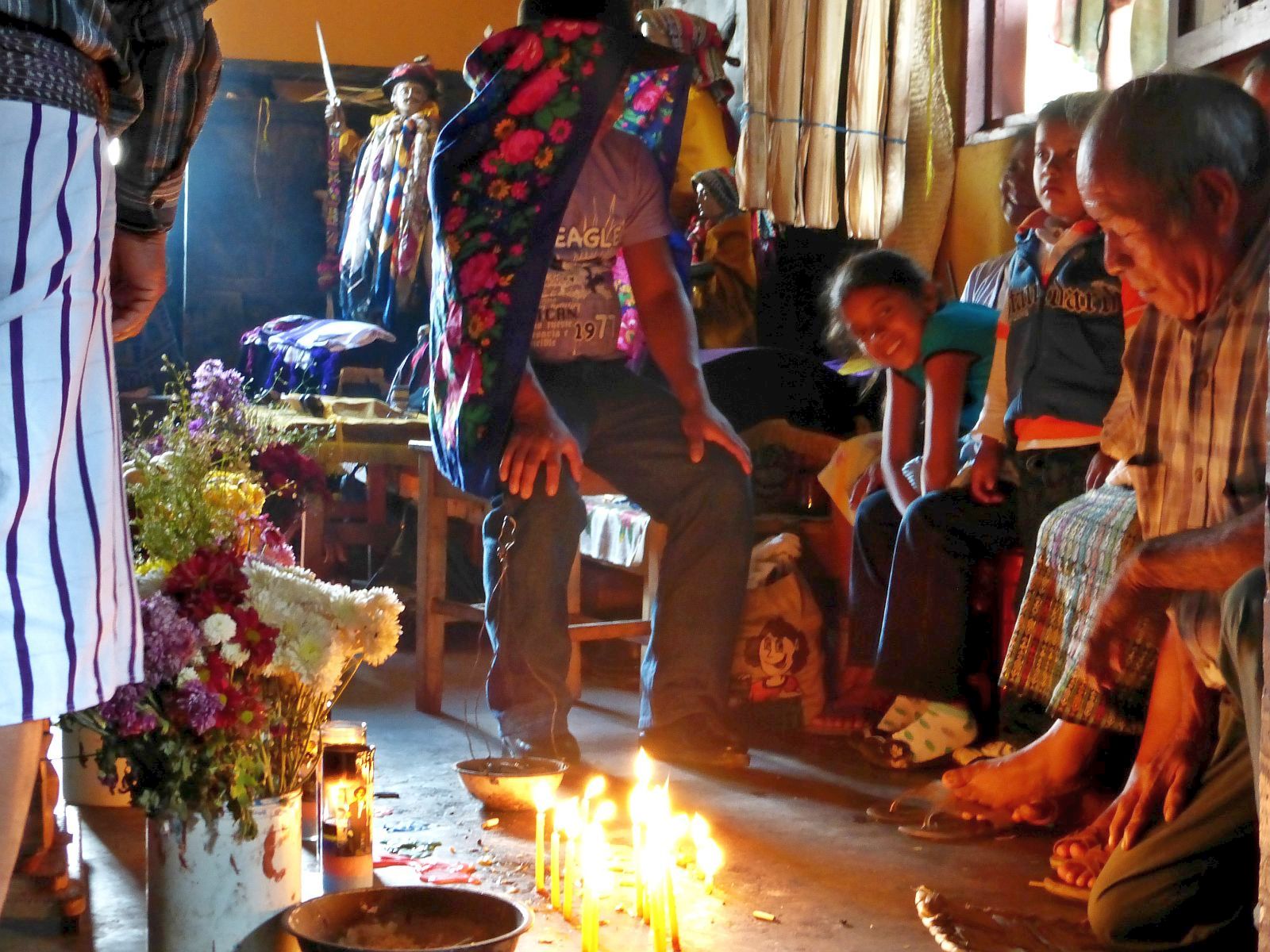
Inside the home, torrents of Copal incense are swirling back and forth, mimicking the laughter of the swaying drunks outside. The drunks are stumbling around their playground bar, gulping plastic bags filled with Quetzalteca that is stockpiled in bottles near the door.
Upon entering, a bored 12-year-old takes our entrance and “permission-to-take-photos” fee and heads off in the corner to ogle the scantily clad supermodels of the local periódico. We sit cross-legged, somewhat outside the ceremonial space, and try to be unobtrusive, a task that, many travelers come to learn, is nearly impossible.
We tease out our cameras and quietly snap a few photos as the ceremony begins.
A Man Asking for Help is sitting on a chair with a cowboy hat that’s drooping with floral cloth. His eyes meet ours for a brief moment, then turn back. Next to him on the bench is his family: a few small and restless children, a smiling wife and a stoic mother. Kneeling on three straw mats in front of 12 lit candles is an elderly man reciting prayers in Tz’utujil.
Patrons at the outdoor bar are cackling in the background and a man in a maroon-colored shirt who’s wearing dark sunglasses is talking on his cell phone as an unkempt dog lies nearby slowly licking his genitals. The Man Asking for Help is sitting inside this chaos, enclosed in the partial safety of family and prayers, and asking his silent questions. The elderly man is straightening out a wax candle stuck to the cement floor.

Ashtrays and candles separate us from Maximón, who is sitting immobilized between two helpers as he calmly puffs away at a Rubio cigarette. The gray ash falls to the floor as the smoke rises. The helpers are pouring him a shot of Quetzalteca and, soon after that slides down his wooden throat, they continue plying him with liquor, this time a glass of Gallo, the popular Guatemalan Beer.
These man are part of the cofradias, a respected few who are tasked with maintaining the proper veneration of Mayan and Catholic deities (observing their feast days, caring for them, etc . . .). This tradition was brought over from Europe to Guatemala by Franciscan missionaries in the 16th century. Their goal was to convert the locals, but the cofradias were reformatted to fit the personalities and schedules of important Mayan deities.
Just like the sudden influx of Europeans during the 16th century, the clamor and disruption of a large tour group is piling into the small room. As they begin complaining about the wafting smell of Copal and dust that envelopes the room, Sue and I know that it’s time to leave. We gather what we brought and slip out quietly, strolling down the narrow alleyway and onto the cobblestone streets.
As we wandered back towards the lancha, I reflected on this enigmatic deity. Maximón’s home had a unique feel to it that arose from the fact that it was not made to be unique. It wasn’t floating on some glorious mountaintop nor hidden in a far-off cave. It was calmly constructed inside a humble room next to a bar down a back alley.
Maximón was very much of this world and the ceremony was a jigsaw mix of the sacred and profane. Perhaps this was best for a saint who drinks, smokes and sleeps around. For someone who has made a mistake or two, this is a saint I could relate to: a saint who, at times, has been unsaintly.
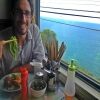 Matt McGuire is a freelance writer and odd-jobs worker with a love for notebook paper, good books and the unwritten lines of the open road. His blog can be found at ThoughtWalks.com.
Matt McGuire is a freelance writer and odd-jobs worker with a love for notebook paper, good books and the unwritten lines of the open road. His blog can be found at ThoughtWalks.com.
The post Maximón: Guatemala’s Chain-Smoking Savior appeared first on The Expeditioner Travel Site.
]]>The post Go To Guate: Climb Acate appeared first on The Expeditioner Travel Site.
]]>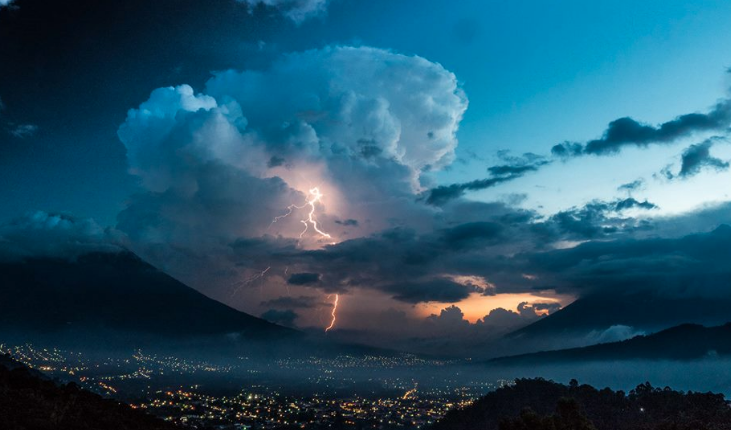
Examining my sleeping bag as I unravel it, I am relieved to see it is a proper sub-minus piece of kit. Not that I’m some sort of born-again Edmund Hillary-type, but you never know with these “adventure tour” outfits — some of them may as well send you off with a handkerchief and a glass egg cup for all the credibility of their equipment.
But nope, not this time. Be gone nature, we have Thinsulate!
I sink back into the legitimacy of down and allow my eyes to close.
BOOM.
Eyes snap open. Bolt upright, I scramble towards the entrance of the tent. Fumbling with the zip, the air fills with whoops and cheers of our fellow campers. Their glee echoes fragile and human above the rumble of earth belly beneath us.
Parting the canvas flaps — and there is no way not to make that sound gross — I gasp. Audibly. Like a cartoon character. Or, perhaps more aptly given the flap-parting, a porn-star.
What. A. Sight.
The moon is rising to the east of us. The sun is setting to the west. A sea of clouds drifts across the floor of Antigua valley, tinged orange, then pink, then violet as night draws in. Gradually stars emerge to pierce the purple blue of a deepening sky, winking coyly to the lightning that dances between distant thunderheads.
Bonfire crackling, colors melting: it’s the magic hour . . .
Then, once again: BOOM!
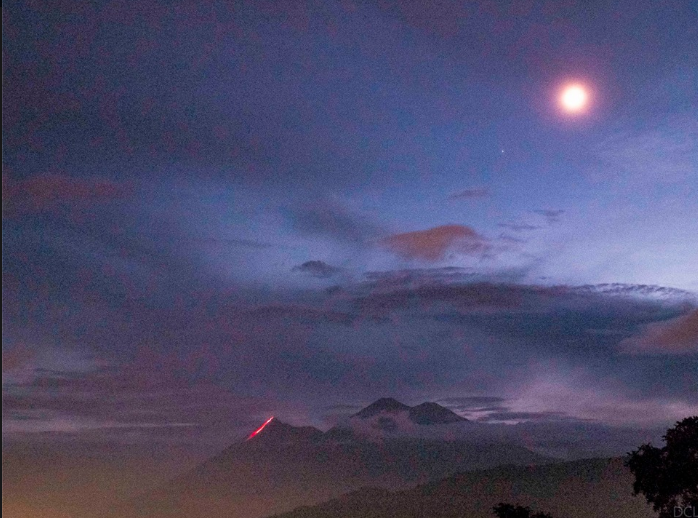
It’s a rare thing to observe a volcanic eruption at eye level, but this is Guatemala, and I have long since come to expect the fantastical. And indeed, here we are on the side of a volcano, watching another volcano erupt.
This shit just got Tolkien.
As the third highest volcano in the country, standing at 3,976 meters, Acatenango affords unrivaled views of its rather more rambunctious twin, Volcan De Fuego. It is, if you will forgive the metaphor, the relative safety of Middle-Earth to a sinister Mordor.
Having said that, I rescind my plea for forgiveness, for this is Gandalf territory indeed, and I defy you to contest this claim once having made the climb. You are even given a staff to assist you in the ascent for goodness sake. I mean, they call it a walking stick, but it’s so much more than that.
The next morning we rise at 4 a.m. to summit by sunrise. It’s high, its early and cold as balls. But it’s worth it.
The peak offers a terrific panorama of the coastal plains down to the Pacific in the South, and across the Guatemalan Highlands — including Lago de Atitlan — to the south. It is up there with one of the most beautiful sights any reasonable individual could ask to see in a lifetime. A smoking crater, 360 vista, proper breathtaking. Not that you’ll be able to take a picture of it if you are relying on your smart phone. Apples don’t like being chilly at altitude, apparently, so be aware that your camera will likely be hibernating when you need it most. Steve clearly wasn’t a man of the mountains. Or just really liked frozen fruit.
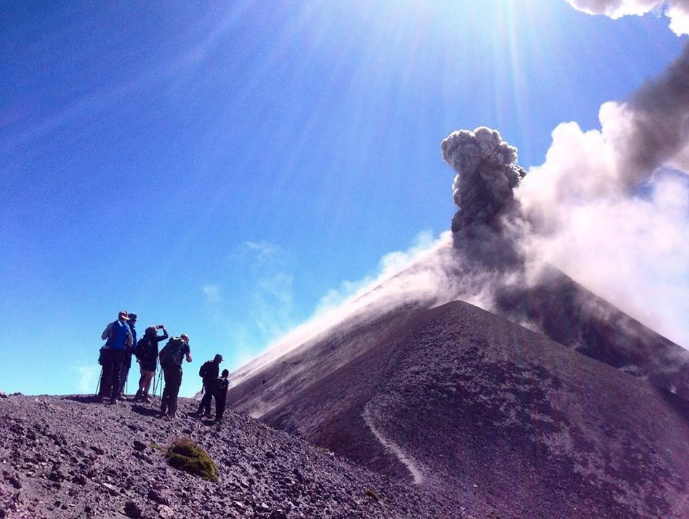
While it might seem that every man and his mother is offering trips up Acate out of Antigua, Guatemala, it really is a case of getting what you pay for. There are plenty of cheap-o alternatives, but having opted for Old Town Outfitters, I can recommend them highly. These guys know the mountains, they know their gear and they know how important it is to work in harmony with the local community.
Unlike the majority of the other tour companies operating this trip in the area, you will start your expedition from La Soledad, a small highland village about an hour’s drive outside of Antigua. Here you will pick up your local porters who, quite honestly, do most of the hard work for you, before setting off through farmlands to the trail, as well as start to get a sense of the role these volcanoes play in the daily lives of the people who live here.
So what are you waiting for? Go forth and channel that inner wizard! Oh, and this is a relatively strenuous hike, so dress accordingly, i.e., don’t be that douche wearing Converse.
P.S. Appropriate trekking attire may also include adorning yourself with a cloak and making the climb as Mr G. The Grey himself. In the event you subscribe to this option, kudos. Also, let’s get married.
***
[Photos 1 – 2 by David Leonowens; Photo 3 courtesy of Old Town Outfitters]
Old Town Outfitters, Adventureguatemala.com.
/
 A journalist, human rights advocate and development professional, Hannah is currently located somewhere in the vicinity of Central America. As Lead Creative for an international freedom of speech project, she is passionately exploring ways to engage people and instigate positive change through innovative use of media, the arts and story. When she isn’t working, she’s probably scuba diving or being angry about Brexit. Life goal? Owning a house pig.
A journalist, human rights advocate and development professional, Hannah is currently located somewhere in the vicinity of Central America. As Lead Creative for an international freedom of speech project, she is passionately exploring ways to engage people and instigate positive change through innovative use of media, the arts and story. When she isn’t working, she’s probably scuba diving or being angry about Brexit. Life goal? Owning a house pig.
The post Go To Guate: Climb Acate appeared first on The Expeditioner Travel Site.
]]>The post 3 Countries To Visit In 2015 If You Don’t Want To Be Lame appeared first on The Expeditioner Travel Site.
]]>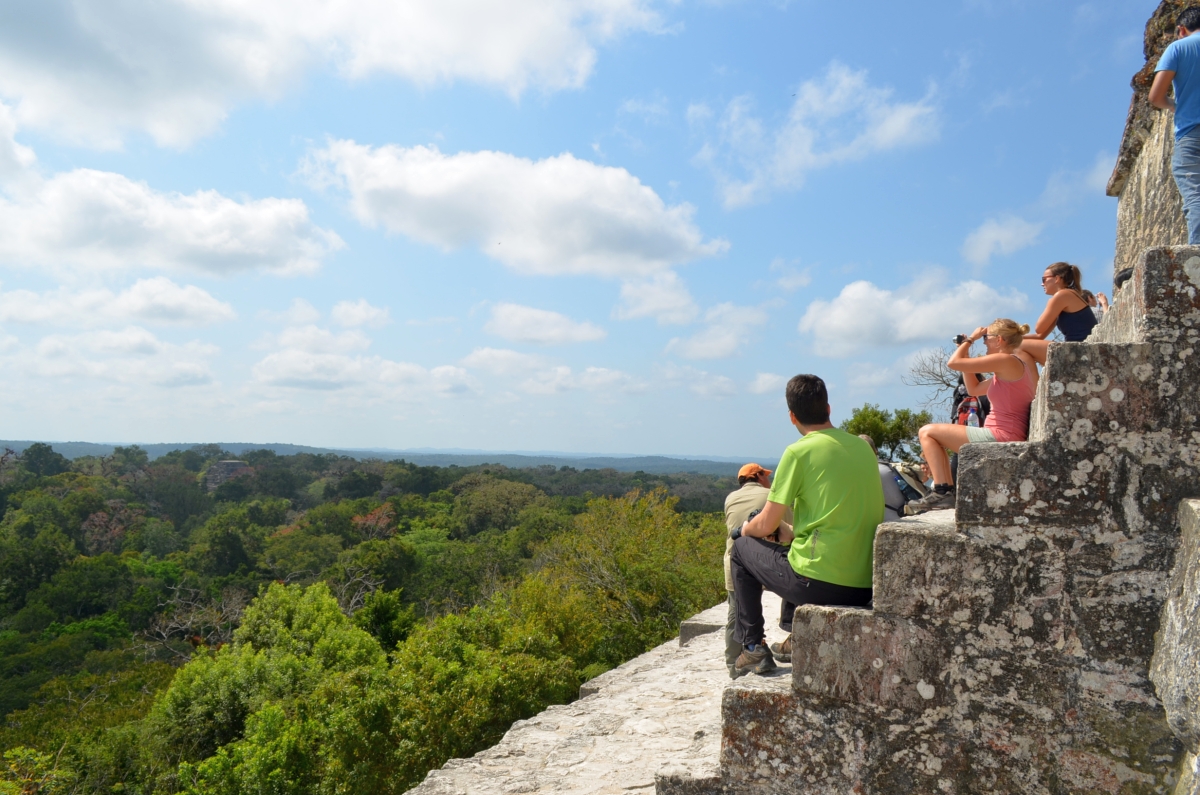
Lonely Planet recently named Singapore their number one county to visit in 2015, which in it of itself is fine, except for the fact that it’s technically a city/state, right? That’s like saying my favorite food in the world is gum. While technically correct, it’s not exactly a satisfying an answer. (Actually, I don’t really chew that much gum — I’m more of a Werther’s Original guy, but that’s besides the point).
They have some other good suggestions on the list as well, including Namibia, The Philippines and Nicaragua, all of which are worthy contenders for your next trip. However, none of them happen to be places that Contiki is highlighting on their “New Destinations” page (except for Morocco, the idea of which I’m pretty sure Lonely Planet stole from Contiki). Weird, right?
That being said, I’d like to highlight three of the countries they offer tours to, not because they made the cut for this list, but because I actually would love to go there (or return to in two of the three cases).
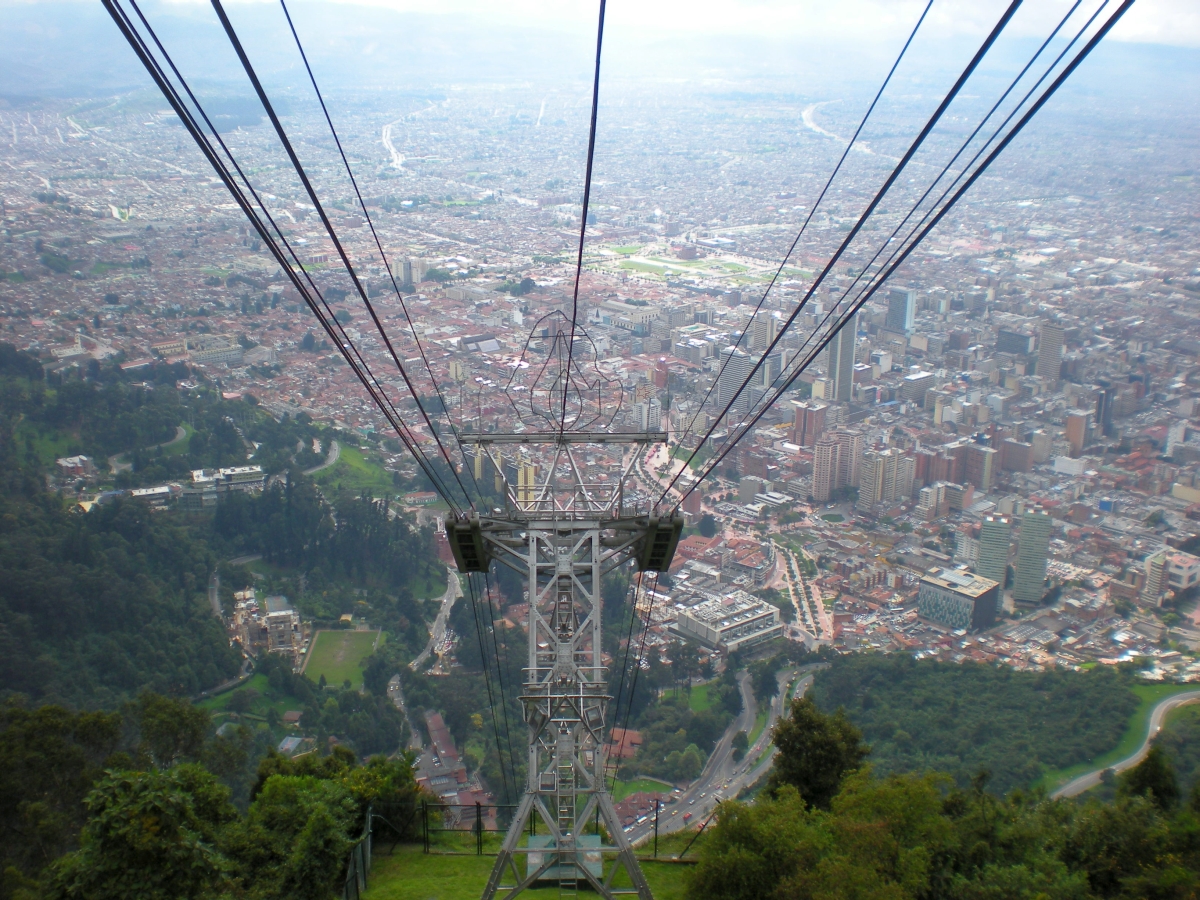
1) Colombia
What else can you say about Colombia? It’s hard to turn on the Facebook without someone mentioning how they’re grabbing the next 5-hour flight to the country to take in the splendor of a country that just a couple decades ago was persona non grata to most of the outside world.
When I was there a few years back, I made a number of videos from around the country in which I traveled to Bogota, Medellin and Cartagena, among other cities, and which I got many comments about how I wasn’t playing the correct music in the background for each particular city’s video. Oh yeah, Colombians are very particular about their music (which is a good thing in my opinion).
What do I remember most about the country though? Probably how much I loved it there, including the food, the weather, the beaches, the people and the absolute insistence too many people had back home that I shouldn’t go. Man, that felt good to go anyways.
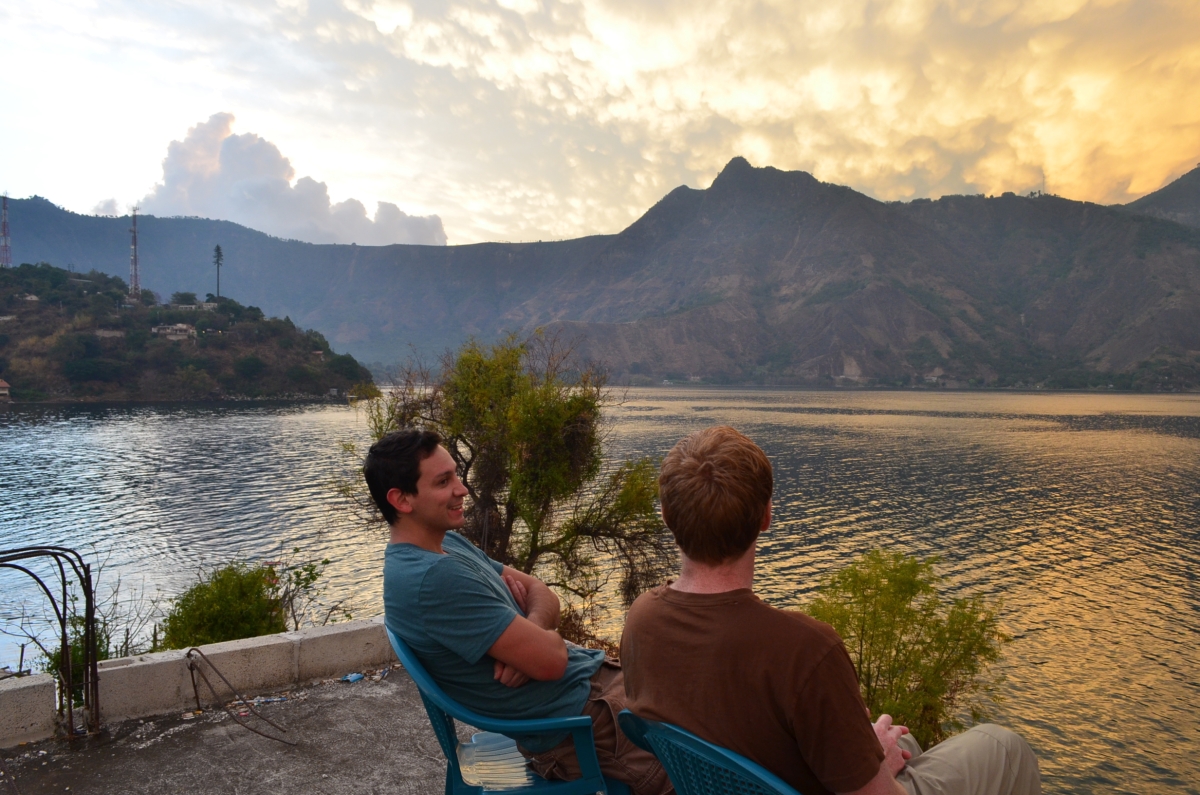
2) Guatemala
My friend and and contributor to this site, Luke Armstrong, is either from South Dakota or Guatemala, I keep forgetting which. What I do know is that when I went down there a few years ago to visit him and his group of ex-pat friends, he was certainly not treated like a Gringo at all. In fact, I think he was affectionately known as “The Man That Wears Shoes Made of Goats,” and was treated like a local.
Under his mastery of the Spanish language, including the many colorful ways to swear, we traversed the country, including stops in the always amazing Antigua, the stunning Lake Atitlan, scenic Semuc Champey and wondrous Tikal. Guatemala is usually my go-to country to suggest when people mention they want to visit Central American but don’t know where to go, and I have fond memories of visiting the county and almost getting burned alive on an active volcano (surprise, I made a travel video from there too!).
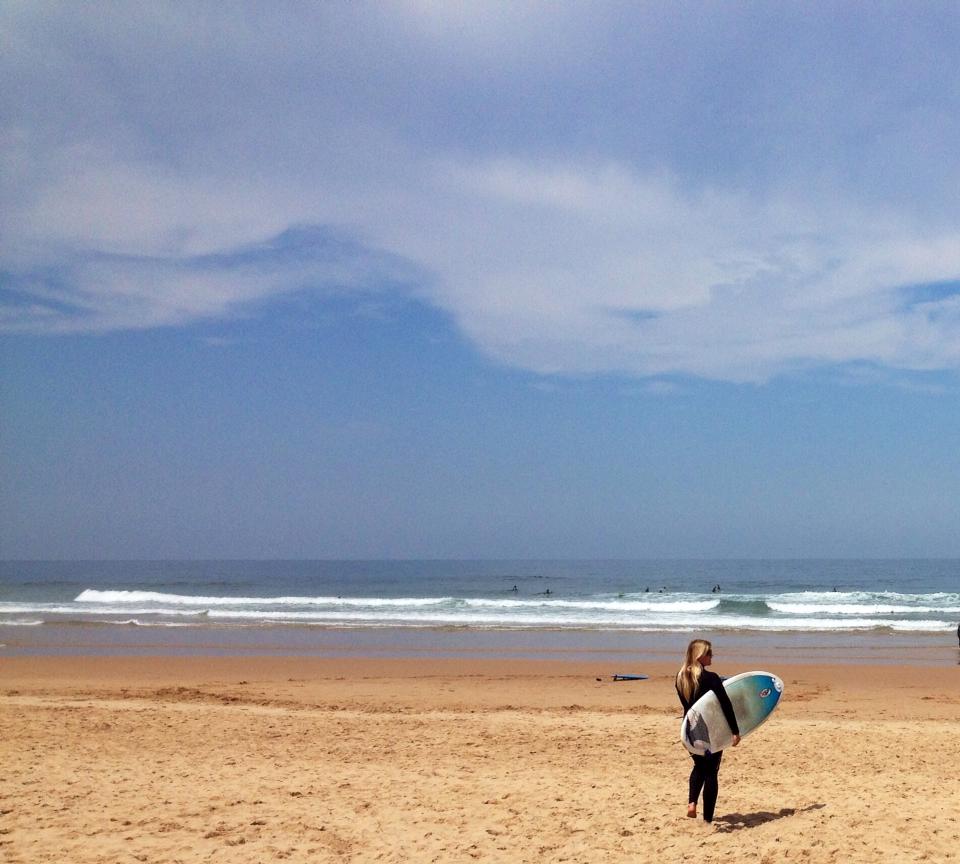
3) Portugal
I haven’t been to Portugal yet, but if there was ever a time to go there, it’s now. Why? Well, try having a conversation with anyone with absolutely any taste or insight into the pulse of “what’s cool” around the world, and I guarantee you will hear the line, “Lisbon is the place to live now,” or “Lisbon is the new Berlin.”
Something about the economic crisis a few years ago, the country’s unwavering attention to its proud culture and the fact that Portuguese sounds so good to the ear makes it perennially one of the best places in the world to travel to.
Portugal is also home to the biggest wave ever surfed (in Nazare), a video of which may be the most frightening thing I have ever seen in my life.

/
 Matt Stabile is the founder and Editor-in-Chief of TheExpeditioner.com. You can read his writings, watch his travel videos, purchase the book he co-edited or contact him via email at any time at TheExpeditioner.com.
Matt Stabile is the founder and Editor-in-Chief of TheExpeditioner.com. You can read his writings, watch his travel videos, purchase the book he co-edited or contact him via email at any time at TheExpeditioner.com.
The post 3 Countries To Visit In 2015 If You Don’t Want To Be Lame appeared first on The Expeditioner Travel Site.
]]>The post My Discovery Of Eden In Semuc Champey, Guatemala appeared first on The Expeditioner Travel Site.
]]>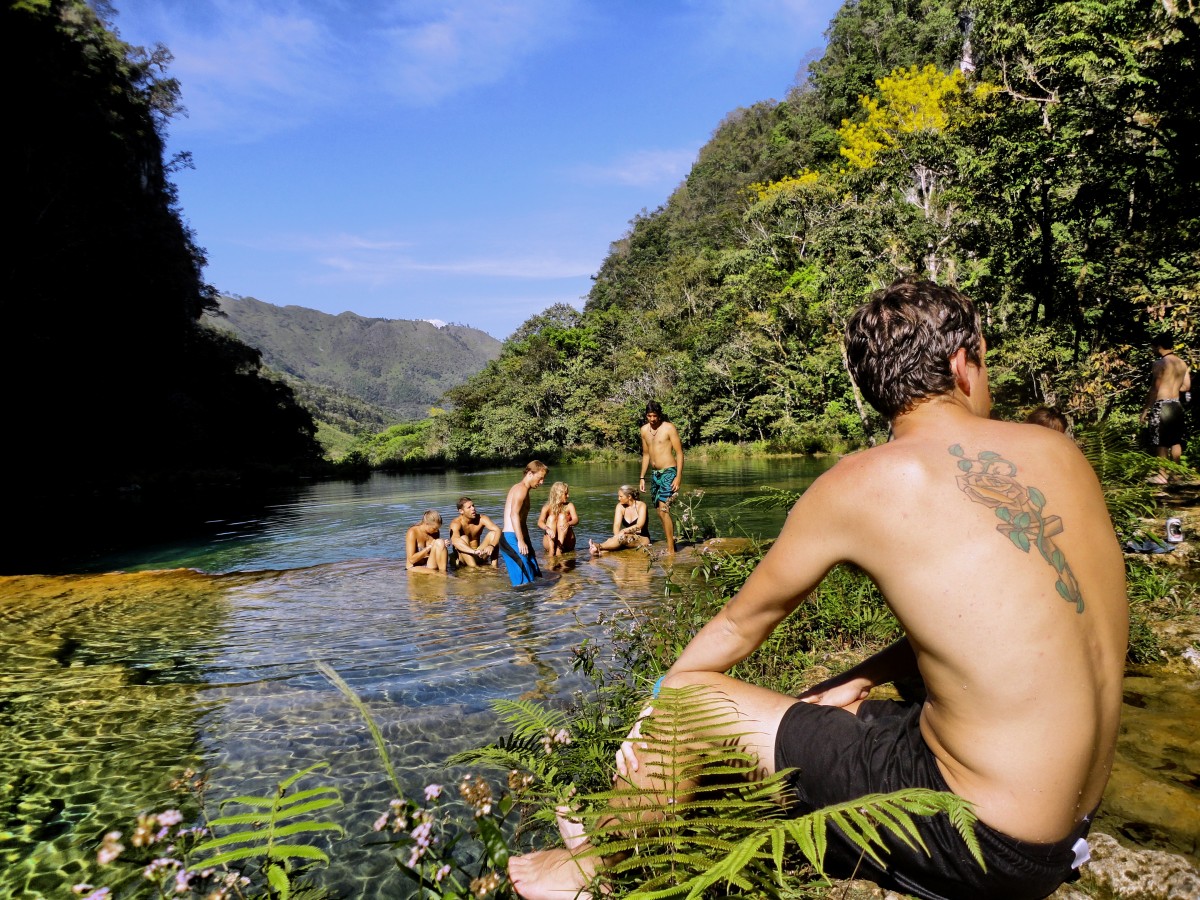
I’m riding in the back of an open truck that must have served to transport cattle at some point, but on this occasion, it is taking me from the town of Lanquín to the secluded community of Semuc Champey, in the heart of the Guatemalan jungle.
Riding with me is my girlfriend and about a dozen tall, heavy-set men. I exchange a few words with some of them and find out they are army guys, taking a vacation-break away from their training base several miles away. Right now though, they look mostly like tourists, goofing around and taking selfies as the jungle zooms by all around us.
The journey began in Antigua, a colonial city of pastel, multicolored houses, many of them former colonial estates, and a multitude of Baroque-styled cathedrals. At night, the cobblestone, quiet streets, dimly lit by the lampposts, transports me back to a pre-industrial era, a stark contrast to the Central Square area, where all the bars and cafes can be found, which give the city its vibrant nightlife and lively cultural scene.
Antigua is a key jumping-off point for moving deeper into Guatemala. From there it is easy to get a 6-hour-long bus ride to the town of Lanquin, some six miles away from Semuc Champey. While the climate is temperate in the higher altitudes of Antigua, the moment you get off the bus in Lanquin, you know you’re right in the tropical jungle.
Lanquín is the last stop where I can get what most Westerners consider everyday commodities, like all-day electricity, cell reception or internet connection. The community of Semuc is found one cattle-truck ride away, on the banks of the Cahabon river. This is a protected natural area and local custom holds great respect for the environment. The locals are for the most parts descendants of Q’eqchi’ Mayans, and many of them still speak — sometimes exclusively — the local dialect, Q’eqchi.
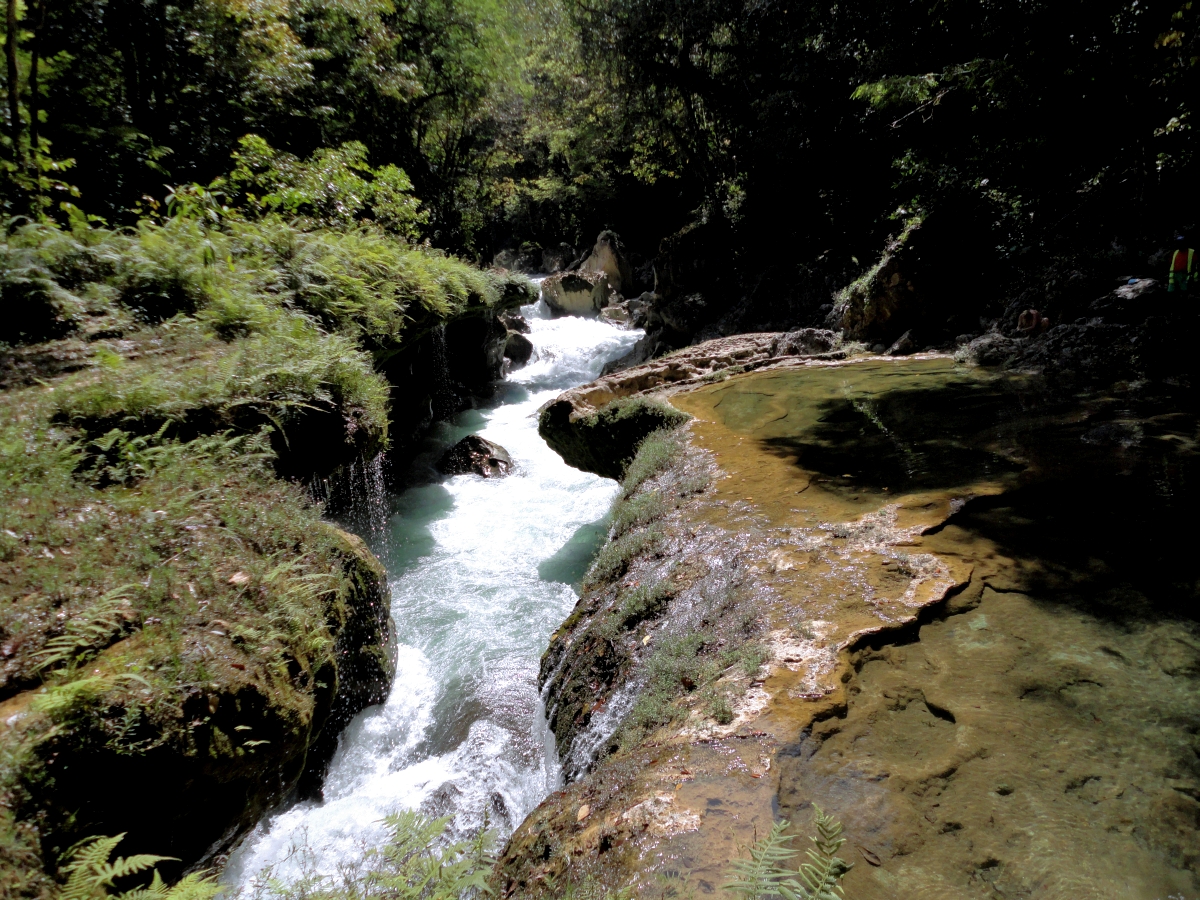
In Q’eqchi, Semuc Champey means, “Where the river hides beneath the earth,” which references a nearby location at the bottom of a steep valley called El Sumidero, where the Cahabón River flows underground, then comes back out at a source called El Manantial. This forms a natural stone bridge over 1,000 feet long, above which are a series of natural, turquoise-colored pools of pure spring water, streaming downriver in a steady flow.
I arrive at one of the few available accommodations nearby, a small eco-hotel called El Recreo, which runs on solar panels and generators, and is mostly built of rock, palm and adobe. A couple of girls in colorful, hand-woven dresses, who hardly speak a word of Spanish, come to greet us and pitch us some of their homemade produce, cocoa candies.
Looking back on it, this was actually one of the most memorable local delicacies I came across. The candies were homemade bars of pure cocoa paste, pressed by hand, mixed with spices, including cinnamon, chili and cardamom. I still sometimes get a deep, nostalgic craving for those spiced cocoa bars that those little girls made by hand and sold for a couple of quetzales to the tourists that came by.
There are abundant cocoa trees all around, and I learn from the hotelkeeper that you can crack a cocoa nut open and find a juicy, tender fruit inside, wrapped around the seeds and strongly resembling a human brain in appearance. The housekeeper tells me that in local lore, this is actually because cocoa fruit is said to be good for the brain. The fruit is sour, juicy and tender, incredibly tasty, and while most of us are familiar with cocoa nut, I realize most people have never even tried cocoa fruit, let alone even known it exists.
There is little to do during the day in Semuc Champey, but what a setting to do nothing at all. I’m inside the jungle, next to the river, reading, swimming and walking around town, which consists mostly of farms interconnected by trails through the jungle.
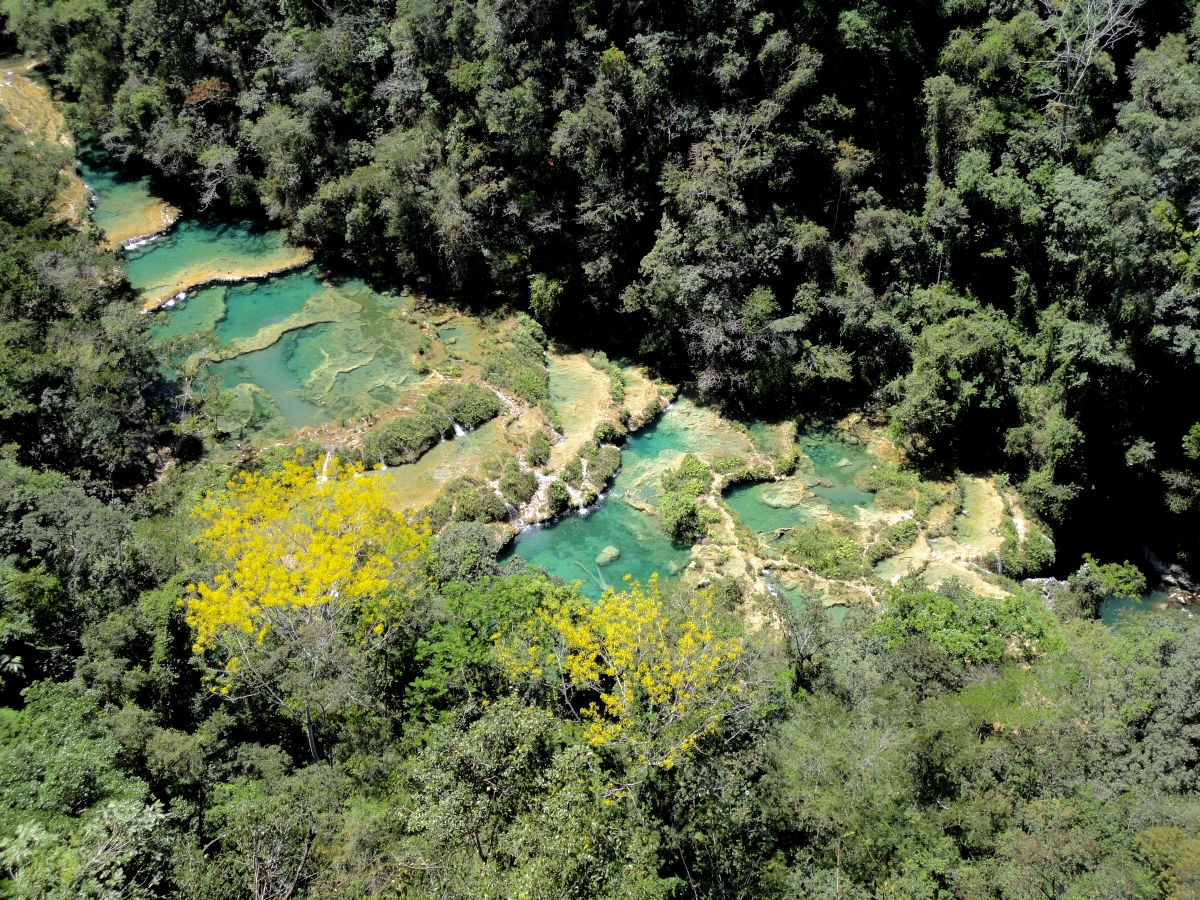
Throughout the days, I end up realizing everything goes at a different rhythm than I’m used to here. My girlfriend and I end up befriending the little girls who sell cocoa candies. They teach us a few words of Q’eqchi’, like Saq’ e’ (Sun) and ha (water). My girlfriend has an easier time learning the language than me. I suspect that after a month talking to these girls, she would be able to speak fluent Q’eqchi. The girls give us a tour around town, including a trip across the natural stone bridge to the entrance of a nearby reserve. On the way, we see the army men swimming in those turquoise pools. They wave at us from the distance, looking like kids fooling around in the water.
I am told there is a cave network nearby called Kam-Ba, where the river flows underground. I am led a couple of miles down to the entrance of a cave. There, we are handed candles and guided in through the complete darkness. The water was sometimes waist-high as I followed the dim light of the guide. Walking in front of me into the cavern, the open space seemed to stretched onward until it could reach the bowels of the earth — a sort-of entrance to a Mayan underworld. Bad idea to lose your light in here, which is exactly what our guide tells us to do after a while. Inside, in the darkness of the cave, all you can hear is the dripping from the stalactites and the occasional flapping of bat wings.
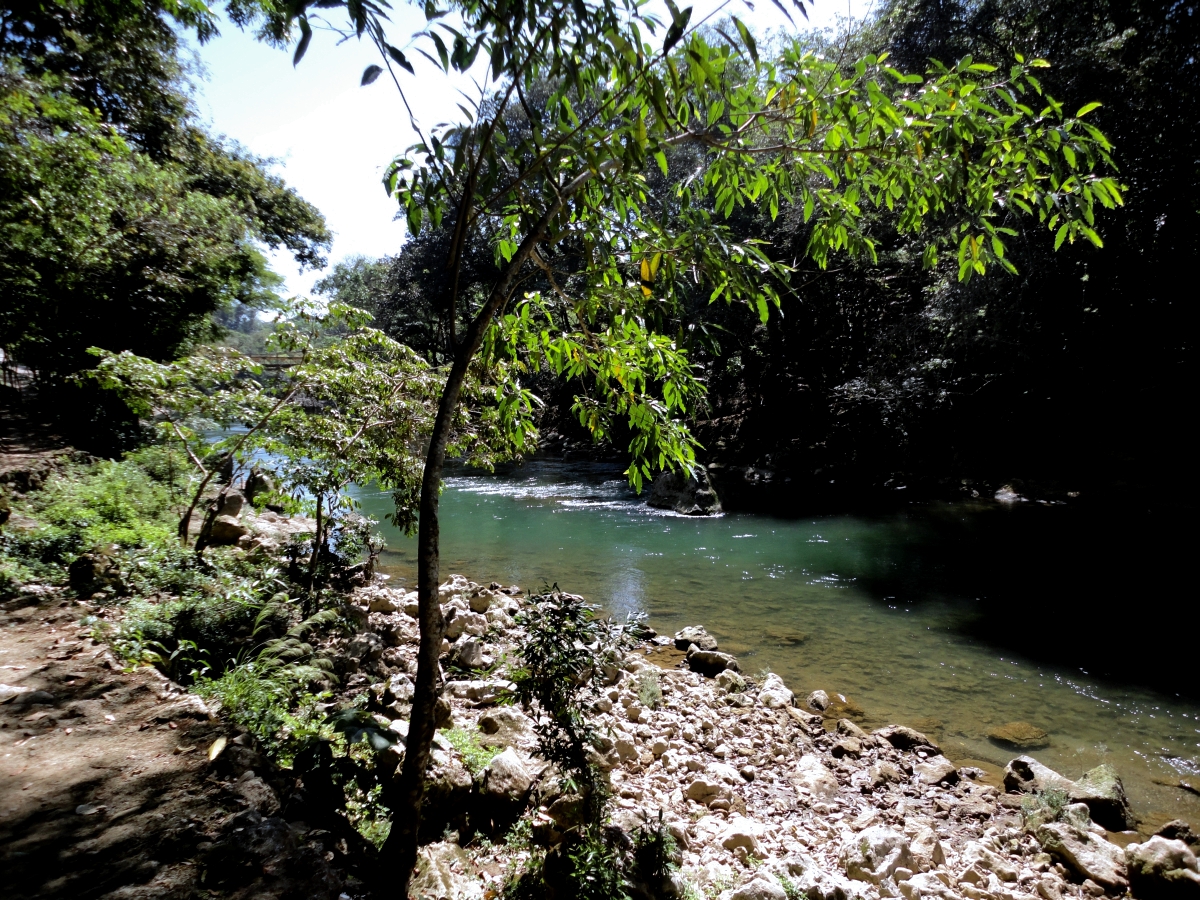
On our way back, I am given an inflatable tire and am allowed to drift on a slow, scenic ride down the river, which ends with a little swim back to the riverbank facing the hotel. I am exhausted. That night we get to build a bonfire on the riverbed with some of the other guests, who are, for the most part, international, barefoot backpackers on a budget, and we stay out stargazing through the treetops, listening to the sounds of the jungle.
There is, in particular, a strident whistling that I imagined could only come from some local bird. Actually, I am told that this sound is emitted by a small insect called a chicharra. There is a constant, chirping, hissing, coo-cooing, all around us. All of these sounds intermingle, creating a rhythmic beat that never ceases. You tend to think that the nighttime in the jungle is silent, but it is actually surprisingly noisy.
It was tough to leave Semuc. After just a few days there I had gotten used to the rhythm, to the constant, high-pitched chirping of the chicharras, and to sitting on the riverbank, watching the river flow.
The girls wave us good bye. The off-duty army members are nowhere to be seen, probably floating downriver on an inner-tube, in the beer-induced stupor that only a leave of absence can bring on. I get my last load of cocoa candy, and the girls wave us off as the cattle truck drives uphill. As we leave town, the humidity lifts instantly, and I feel like we’re leaving a small patch of Eden behind.

/
 Mateo Garcia is a freelance author, journalist and travel writer. You can check out his blog at TrippyFiction.blogspot.com.
Mateo Garcia is a freelance author, journalist and travel writer. You can check out his blog at TrippyFiction.blogspot.com.
The post My Discovery Of Eden In Semuc Champey, Guatemala appeared first on The Expeditioner Travel Site.
]]>The post Turning The Car Around: One Road To Expatriatism appeared first on The Expeditioner Travel Site.
]]>
Stories can be told from limitless angles of perspective. So let’s begin this tale from the viewpoint of a Salvadorian family living in a small, rural village. It is a sunshiny day in a one-goat town a few hours drive and world away from the busy capital — a place far removed from the beaches and bars where gringos tend to roam. The day begins no different as previous days, weeks and months. A young couple with a four-year-old son and eight-year-old daughter tend their one-room store across the street from their home. One of their more valuable possessions, a female goat, is tied in front of their store.
Then comes a moment that will lead to a story that their children will retell to their friends at school, mother will recount at family fiestas and the father will tell his soccer buddies, that — sí, no les miento — this really happened. An ’88 Volkswagen Jetta pulls up to the front of their store. Inside are three road-rugged gringos, a puppy and a baby goat.
The gringos get out and begin to chat in shaky Spanish with the family. Pleasantries, smiles and nods are exchanged. Then the gringos huddle and converse amongst themselves in English and come to an agreement. They go to the car, fetch the goat and present it to the now elated family as a gift. This day has taken a unforeseen turn that no previous day, and let’s be real, no subsequent day, is likely to take.
They way stories in the village are swapped and embellished with each telling, we can only guess 10 years from now how the “gringo goat story” will be told: They were gringos — seven feet tall — having just returned from rescuing the goat from a burning barn where every man, woman, child — but not the goat — was killed, so they came to our village and gave us the sole surviving goat.
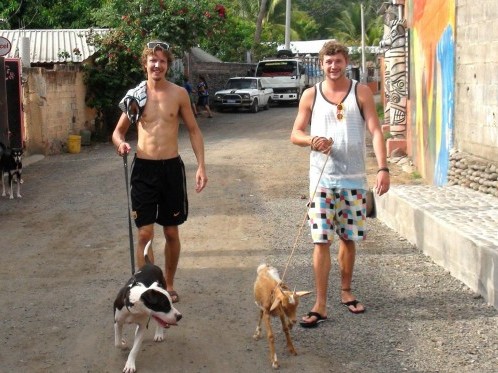
Actually, the goat was a gift for Derek Girard on his 26th birthday. Since he was a kid, Derek had an obsession with goats. To this day, goats are his favorite animal and he loves them with the passion that Miley likes controversially shaking it. He and his younger brother Dustin have had the tradition of one-upping each other on their birthday. Derek will have troubling one-upping the goat (Dustin’s favorite animal is an elephant).
Getting the goat was no easy task. Dustin and friend Dan Pangman spent five hours in the Salvadorian countryside searching for one that was for sale. The process might have been shorter, but prior to El Salvador, the trio had spent time learning Spanish in Mexico, where word for goat, chiva, in Salvador means, cow.
USD$20 and a language lesson later, they had a baby goat, which “shit all over the hostel and ate the garden.” The goat joined the rag-tag trio and took long walks on the beach with them and their 4-month-old puppy in the surf town of El Tunco, El Salvador, before reluctantly, and with heavy hearts, they realized that the goat needed a family; one with a mother and father whose M.O. didn’t consist of smuggling the goat — who couldn’t stand to be away from the trio — into hostels.
Let’s Back Up a Bit Further In the Story
Dan and Derek met when they were both hired by marketing firm JTI, a company which throws massive parties. Part of their “research” consisted of being flown to Toronto to party in exclusive VIP areas of bars and club. Their research paid off. The party they threw in Vancouver was voted the best party in Canada, which netted them a free trip to Miami (is anyone jealous yet?), where they were ushered into a Miami Dolphins games, and onto exclusive yachts for more, yes, partying.
It turned out the pair had more in common than knowing how to throw a killer party: both had spent three months volunteering in Tanzania, an experience that had stayed with them. Though they were having the kind of fun we must imagine two guys in their twenties must have been having working to throw parties, there was a tug towards something they considered bigger.
Our lives tend to plateau into daily routines, and one chance meeting, one conversation, or one decision is all it takes to shake things up and change everything. A conversation that decided their fate and set out a new course went something like this:
“I want to get out of here, quiet my job and travel,” Dan told Derek.
“Bullshit, you are,” Derek told Dan.
“Yes, I am.”
“If you are, then I’m going to do it too.”
“No, you’re not?”
The challenge was on the table and they both egged each other on enough to meet it. They put in their one month’s notice and soon they were jobless and sitting next to each other in a 1988 Jetta, with a vague plan to make it through South America. “It’s a beauty car,” Derek says with a look reserved for talking about beautiful women. “We’ve done so much off-roading in that bitch.”
Along their way they met Derek’s brother Dustin in Antigua, Guatemala, where they planned to only stay a few weeks. Derek says that it was not difficult to convince his brother to leave his North American routine life behind and join in on the adventure. After staying longer than they planned, they finally left Antigua and headed to Guatemala’s Caribbean coast where they spent three months volunteering in Rio Dulce. Derek describes it as a place where, “a cut becomes an infection in a second and you fall apart pretty quick.”
So again, they came back to Antigua to recharge their batteries, planned to stay a couple weeks but stayed a couple months before they were back on the road. They made it as far as Panama. There they were supposed to ferry their car across the canal and continue their travels on a fresh continent, but they felt a tug of having left something behind.
“Antigua had our heart,” Dan says, “We needed to go back.”
As expats in Antigua know, that’s the story of how many a two-week tripper turned into an Antigua Expatriate. Of the countless places they stopped off across the thousands of miles of their journey, it was Antigua, that magical “fairy-tale city” in the highlands, that felt like home.
In their previous stays, they had helped friends, Carlos and Carolina, throw a successful party at their corner bar Porque No, and after juggling around dozens of ideas about what they would do, they decided to “stick with what [they] knew” and open a hip-hop bar. Their goal had been from the beginning to use their talents to give back, to volunteer their time and support efforts, and they saw their vision for their bar as supporting that.
“You have to support your life at some point,” Dan says, “We’re passionate about travel and volunteering and giving back, and this is a way to do that on an ongoing basis.” Dustin and Derek are on the same page. “Our trips were about the pay-it-forward model, giving people good vibes. The law of attraction says that when you give out positive vibes, positive vibes come back to you.”
But this is easier decided than done. In Antigua this is an uphill battle for three gringos needing to get through a pile of paperwork and licensing. Most people “in the know” around Antigua would have told three gringos barely speaking the language a sarcastic “Good luck.” But perseverance and good vibes are a powerful combination, one that can beat most odds, and after eight months of tireless work, and struggle against what some thought a pipe dream, they found themselves serving up opening night drinks.
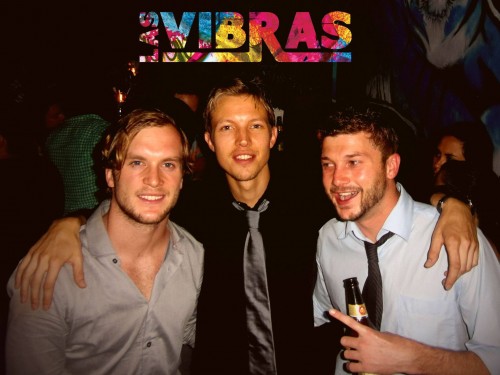
La Vibras Opens For Business
It’s opening night at La Vibras (Spanish for Vibes) and the house is full. The crowd is a dense concentration of Antigua’s heavy-hitting expatriates who have come to show their support for Derek, Dan and Dustin’s endeavor. That presence means a lot. It means they’ve carved deep inroads into the community. Upon my return to Antigua the month before, it was nearly impossible not to meet Derek, Dan and Dustin, as it seemed most everyone in town not only knew them, but also had nothing but good things to say about them.
I am walking around with a digital recorder interviewing people who are all ecstatic to be here. In the very least, everyone is excited about the free drinks from 6-8 p.m. This means by 8 p.m. I am drunk, and in good, bacchanalian company. Listening to my interviews as I write this, they crescendo with my level of imbibing. Unnecessarily aggressive interviewing fueled by joyous inebriation and rude interruptions and rambling questioning, I decide is the appropriate term for my voice I am listening to.
Everything I record after 9 p.m. is painful for me to hear, but I type out the important stuff and then delete the recordings for fear that these could fall into the wrong blackmailing hands — my interview with Derek sounds more like harassment than reporting. Upon his saying, “I believe everything happens for a reason,” I hear my voice respond, “What do you mean? Does everything happen for a reason, because some people die sad and alone?”
WTF, Luke? But the vibe of Las Vibras is one where everyone is enjoying themselves to the max. Antigua, and other such dots on the expatriate map, is a place where a vision like this can materialize when a person commits to their casual daydreaming. The consensus seems universal: Derek, Dan and Dustin are refreshing to have here, opening a kind of bar that the community was lacking: “Where sleek meets the street,” as Derek puts it.
The night began with Dan playing music, both covers and original, on his acoustic guitar, and then led to upbeat hip-hop and pop music. People are drinking, dancing and admiring the graffiti art covering every wall. Alex, a British expat in Antigua, spent three months perfecting and finishing the wall art. He painted the exit signs the day before opening night.
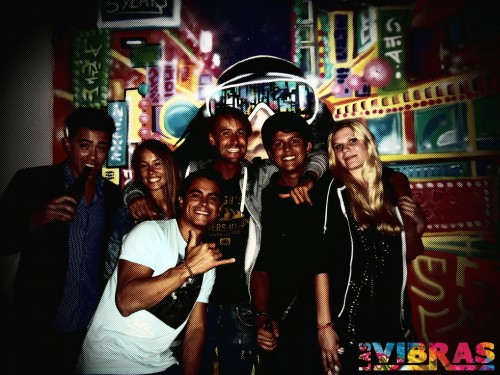
When you follow the line of cause and effect long enough, you see that all of this — the swaying revelers, the art, the music, everyone in this room — is the result of a conversation that led to a dare, which led to not backing away from a risk. Dan put it perfectly: “A risk like quitting your job, going traveling, following your dreams — it’s riskier not to take it. You can always revert back to your mainstream lifestyle, but you can’t go and live out that dream when you let it pass by.”
Derek, basking in the glow of a successful opening night thinks back to the eight months it took them to get to this point. “It’s all about positivity. Every time you get a no, it’s just a challenge. They can say no to us all we want, but we are going to continue going. They say, no no no no, and we say yes yes yes yes.”
“My life in Canada was not based on happiness,” Derek continues, “it was based on all the wrong reasons. The pressure that they put upon you in society to be successful, graduate from high school, then get a degree and a job and start working. I am going to live life for happiness. If I’m happy, I can make other people happy, and if I’m miserable, I can’t.”
No one here tonight seems miserable. There’s a special vibe in the air, and the buzz of “the new place” has yielded to a night when La Vibras opened its doors and invited the world at large to come on in and throw back a round.
On my recorder, I skip through several hours of irrelevant interviewing I conducted near the bar. It seems by 11 p.m. that I am using my microphone exclusively to try to talk to girls; only occasionally remembering to ask them about the bar. “I’m stoked,” a Peace Corps volunteer says over the sounds of music and people enjoying themselves, “tons of people, great vibes, music is good, this is great.”
And just as a goat in El Salvador found an improbable home in the countryside, it seems that Derek, Dustin and Dan have found theirs in Antigua.

About the Author
 After setting out to hitchhike from Chile to Alaska, Luke Maguire Armstrong stopped in Guatemala where he spent four years directing the social service programs of the charity Nuestros Ahijados. He is the author of iPoems for the Dolphins to Click Home About, which is especially enjoyed by people “who don’t read poetry.” His new book, How We Are Human, was recently released. (Follow Luke on Twitter: @lukespartacus)
After setting out to hitchhike from Chile to Alaska, Luke Maguire Armstrong stopped in Guatemala where he spent four years directing the social service programs of the charity Nuestros Ahijados. He is the author of iPoems for the Dolphins to Click Home About, which is especially enjoyed by people “who don’t read poetry.” His new book, How We Are Human, was recently released. (Follow Luke on Twitter: @lukespartacus)
The post Turning The Car Around: One Road To Expatriatism appeared first on The Expeditioner Travel Site.
]]>The post You Haven’t Experienced A Sunrise Until You’ve Done So In Tikal, Guatemala appeared first on The Expeditioner Travel Site.
]]>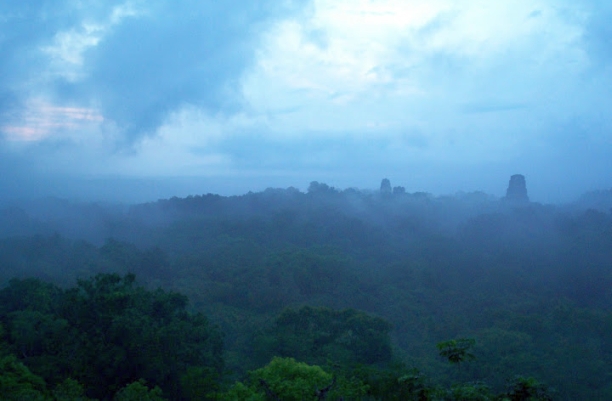
The only thing more magical than hiking through a jungle in the dark, following a path that must be made of white gravel because it glows faintly in the full moon, is hiking through a jungle in the dark past big black hills — blacker than the sky behind them, blacker than the trees that catch the moonlight — hills you know just have to be pyramids. This is Tikal, Guatemala. And getting up at 2:30 a.m. to make the sunrise tour suddenly feels worth it.
As I walk, I wonder about the guide, somewhere ahead of me in the darkness, urging us on through the night, not winded at all, like I am. This magnificence has probably grown commonplace to him — dull, almost. Does he ever wonder how these never-ending waves of travelers can keep marveling at something he sees every day?
A towering ceiba tree reaches pale arms into the sky, and the guide stops us for a moment. The ceiba, he tells us, symbolizes the connection between the underworld, the terrestrial world and the skies. Certainly I can feel that now as the ceiba disappears into the darkness above and the darkness below.
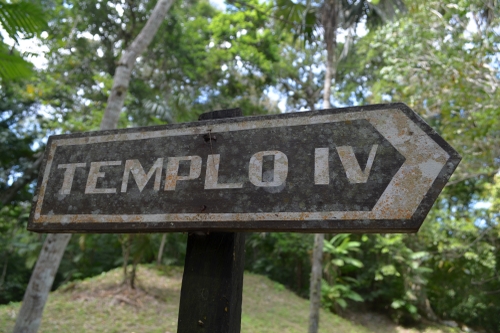
Our guide leads us onward through misty patches and bits of visible ruins. Finally, we reach Templo IV and slowly climb the long wooden stairs to the top, where other groups have already arrived, all sitting in clumps, talking softly so as not to disturb the reverence that swathes this island temple in its own sea of foliage.
It’s barely getting light, the black turning to misty blues and butter yellow as we watch the sun burn off the fog. It rises over an endless jungle, where the only signs of civilization are the tips of Mayan pyramids that have ruled here for over a thousand years.
The birds begin to chirp. Just a few, scattered here and there. Then we hear it: a low rumble, starting at a distance and coming closer and closer. An invisible menace stampeding toward us over the giant leaves of the canopy. It takes me long moments to understand: rain. The patter grows louder, turning into its own sort of music as we pull out cheap plastic ponchos and umbrellas. Still we sit, rooted to the spot by respect — worship almost — for the power of nature. The rain hits hard, drenching us immediately. Just as quickly, it rolls on past. When the roar of the rain turns to a drip-drop chorus, the birds take up the melody, fully awake now — a cacophony of life.
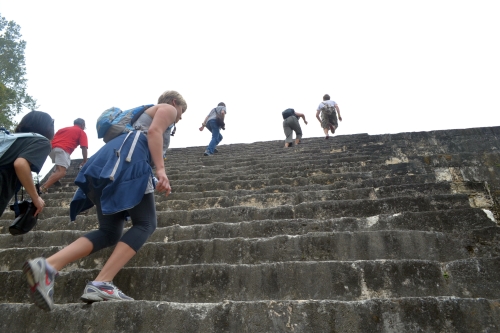
Our guide watches with us, speaking only to call us to silence, for meditation, when some of the young backpackers grow restless. Raindrops and dewdrops in the trees catch the morning sun like strings of Christmas lights. I want to stay forever.
Finally we have to go; there are ruins to see, stories to hear, pyramids to climb. Our guide, apparently not immune to the wonders of his job, excitedly shows us a groundcover plant whose leaves close up when he touches them.”Sleeping,” he says as we poke gently at the plants and jerk our fingers back when they move, animal-like.
He takes us off the trail to smell aromatic flora and look for ant hills, under which dwell the clever leaf-cutter ants, one of the few animals to “process” their food. After they cut their jigsaw pieces of leaf, they leave them to ferment with their own saliva. A fungus grows and they feed the colony from that. I see evidence of their handiwork, now that I know what to look for, but I can’t find any of the actual creatures.
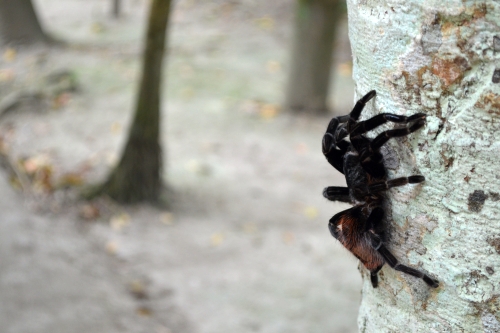
Undaunted, our guide quickly pulls our attention away and points out what some people call the tree of love, because it embraces other trees. Its alternate name? The killing tree, because its embrace eventually chokes the life from its jungle companion. But before we can ponder the symbolism of that, our guide finds us a tarantula and delightedly hands it around. I take it. After all, I’ve just been cave swimming and rope ladder climbing down a waterfall, and Guatemala’s making me brave.
I love the serenity of Tikal: the lack of insistent hawkers, the verdure everywhere you look, the gorgeous steep temples, the foliage that can hide other tourists well enough to give you a temporary sense of solitude.
However, Tikal has not always been so quiet. An estimated 4,000 structures remain, only 20% excavated. Anthropologists believe that the commoners lived in open-sided buildings of wood and palm thatching, which have long since dissolved into history. How huge and bustling this city must have been at its heyday, and all without natural water. The Mayans dug their own wells out of rock and lined them with lime, collecting enough of the 70-some inches of yearly rainfall to last them through the dry season.
It’s hard to believe — while standing beneath the giant trees, or surrounded by leaves half as big as me — that this wasn’t always jungle. The wild beauty crept in only after the Mayans abandoned Tikal 1,000 years ago. I imagine the jungle lurking on the outskirts, like an animal, waiting to take back its home.
At Tikal, they also staged the famous basketball-like games involving ritual sacrifice. One theory is that as a finale, they killed the captain of the winning team because he had proven himself worthy of the honor of fighting against the evil gods in the Underworld.
I stand in one of Tikal’s now-grassy ballcourts, surrounded by steeply slanted stone walls, and I can imagine it all: the carved stone hoops mounted on the walls, the ricocheting ball, the crowds roaring with religious fervor, the muscled and bare-chested warriors locked in a life-and-death struggle. I close my eyes and see those same brave players, dead now, trapped amid the roots of the ceiba tree, trying to break free to fight the unstoppable gods of the Underworld, and I come to the realization that, honor or no honor, this is one game I would try to lose.
After the guide sets us free to explore on our own, I scale Templo V, all 187 feet of it, via a modern wooden staircase so steep it’s more like a ladder. They built it to keep tourists from injuring themselves on the sharply angled pyramid steps. I sit at the summit, dizzy with the height, while across the jungle rises Templo IV, where I so recently watched the jungle wake up. I think back to the day before, and how I’d debated about the sunrise tour. 2:30 a.m? Were people crazy? No. People aren’t crazy. But the world is amazing.
By Melinda Brasher

About the Author
 Melinda Brasher spends her time traveling, writing fiction, and teaching English as a second language in places like Poland, Mexico, the Czech Republic and Arizona. Her talents include navigating by old-fashioned map, combining up to three languages in a single incomprehensible sentence, and dealing cards really, really fast. Check out her blog at MelindaBrasher.com.
Melinda Brasher spends her time traveling, writing fiction, and teaching English as a second language in places like Poland, Mexico, the Czech Republic and Arizona. Her talents include navigating by old-fashioned map, combining up to three languages in a single incomprehensible sentence, and dealing cards really, really fast. Check out her blog at MelindaBrasher.com.
The post You Haven’t Experienced A Sunrise Until You’ve Done So In Tikal, Guatemala appeared first on The Expeditioner Travel Site.
]]>The post 8 Stunning Photos From Lake Atitlan appeared first on The Expeditioner Travel Site.
]]>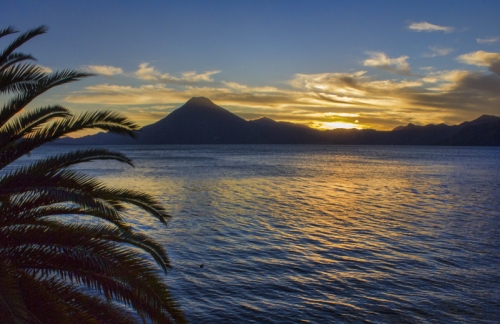
Lake Atitlan in Guatemala — the 1.8-million-year-old 600-meter-deep volcanic lake located a couple hours from Guatemala City — is usually the highlight of anyone’s trip to the country, with its picturesque volcanoes towering over the lake, the small villages clustered along the shorelines and the chocolate shaman who seek spiritual enlightenment in cups of cocoa.
The vagabond Canadian duo behind Hecktic Travels, Dalene and Peter, recently visited Lake Atitlan and put together this photo essay of stunning photos from the lake — including the above picture — complete with sunsets, snowball-shaped clouds and dormant volcanoes. If this doesn’t get you booking a trip there, than nothing will.
For more images of Lake Atitlan, check out my Travel Guide to Guatemala video here.
[Lake Atitlan in Photos via HecktickTravels.com]
The post 8 Stunning Photos From Lake Atitlan appeared first on The Expeditioner Travel Site.
]]>The post My Encounter With Keith, The Chocolate Shaman Of Guatemala appeared first on The Expeditioner Travel Site.
]]>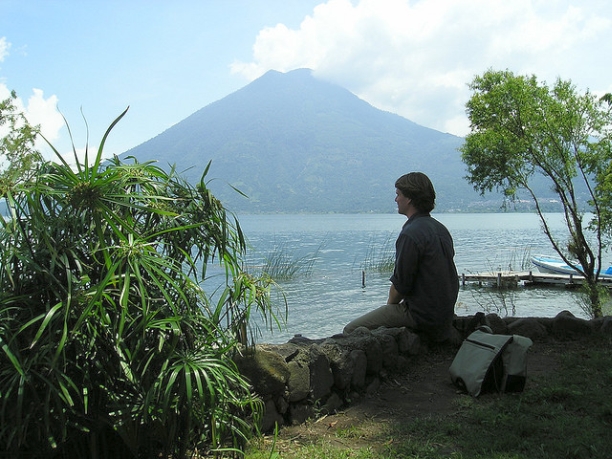
The mist smells of banana leaves and wood smoke, the scent of the Guatemalan highlands when it rains. Mothers carry firewood on their heads and get knocked around by a downpour that’s like bowls of dirty water being thrown from the sky. Village children in hand-woven clothes hide under a tree and squeal as workers get soaked. Clouds shroud the mountains around the lake. As I traipse past a tienda, young Mayan girls twirl floury tortillas and toss them on the hot iron skillet next to the crackers and bottles of Coke. In and out of the shop wander flea-bitten dogs who take over the streets at night, fighting in packs and howling into the grey dawn.
I reach the Chocolate Shaman’s cottage on the village outskirts in the early afternoon. There are a lot of us there — maybe 25. You could take a snapshot of the people sitting on the shabby porch and think it was a postcard from the 1960’s. No Guatemalans, just plenty of folk my age born decades too late; dreadlocks, tie-dye t-shirts and crystals threaded on string around their necks. I recognize most of them — I’ve been taking Spanish lessons in the village for the past week, and most of them work in the cafes and meditation centers by the lake. The tourists left as soon as the rains came at the end of May.
A little American kid with long, tangled hair sits quietly on the tiles under the banana plants. He seems so fragile sitting there. Everyone huddles together on the peeling benches or cross-legged on the floor. A happy buzz floats in the air as the regulars catch up with each other. Having lived around the shores of Lake Atitlan for a month or a year, most everyone knows each other, and most come week after week for the Chocolate Shaman’s group sessions on Wednesdays and Sundays. I am not part of the scene, just listening in on the conversations happening around me.
“I wasn’t going to come today,” says an American woman in her forties with the faded green swirls of tattoos on her forehead and chin, “but the stars were so good, you know, how could I not?”
“I know, right?” says a little sparrow of a Spanish girl, her brown eyes too big for her delicate face. “I swam in the lake today, my hair is getting so healthy out here.”
“It’s the cold water,” says the older woman, “I haven’t washed my hair with shampoo for years, I only wet it once a month when I put in henna.”
“Your hair’s perfect,” says the girl.
“It washes itself, right? I never use soap or moisturizer either. Just cold water. My skin’s never been better.”
Eventually, Keith the Chocolate Shaman comes out of the crusty kitchen and looks behind us to the volcanoes across the lake; they possess all the spiritual energy in the world he says.
With his wispy, white long hair, Keith is an American chocolate wizard. Keith is Dumbledore: ancient, thin and long-limbed. As he folds himself into the cushioned chair by the kitchen door and welcomes us in, I take in his papery white skin and blue eyes so alive behind the glasses. I can’t tell how old he is. Sixty? Ninety? He’s been travelling all his life but there is still a youthfulness traced in his narrow features.
One of Keith’s chocolate helpers is Kurt, the Californian manic who looks like an all-knowing, pierced sewer rat. Last night at the party in the bar I went to, he led San Marco’s souls into a wild percussion dance under the garden’s soaking avocado trees, chanting in time with the tambourines.
Kurt and Keith hand out the 100%-cocoa drink in colorful plastic beakers. There are tubs of brown sugar and chili sauce being passed around for extra kick.
In his warm voice, Keith tells us how the the powerful Mayan Cocoa spirit came to him years ago in a dream. She asked him to wait for a sign from her. A few weeks later, while volunteering on a botany project in Guatemala’s coastal rainforest, he noticed cocoa trees growing everywhere. He learned about the use of cocoa as a drug by searching the web, brought kilos of the stuff back down from the rainforest, and so came the incarnation of Keith the Chocolate Shaman.
“The cocoa is not a hallucinogenic, which has made many overlook its powers, but boy, this stuff, it’ll speed up and open your heart and mind, and what we’re going to see today might just be the most beautiful thing in the world.”
I drop some chili into the acrid brown liquid and swallow back the harsh mix.
“Chocolate brings the door but doesn’t push you through it,” Keith continues. If you really want to stay safe in your rational mind, nothing but a good buzz will happen.”
While we wait for the cocoa to mess with our hearts, Keith tells us some stories. Back in his Woodstock days, Keith made money running workshops that taught hippies how to survive on their travels, including teaching girls how to pee in the woods. He smiles and shows us how, making a lewd gesture with his long, bony fingers. In the early nineties, he worked as a therapist in New York City with gay men who were HIV positive, some of the most creative people he ever met. Then he moved on to work in one of America’s highest-security prisons with men who would die in prison. Now he is solving the problems of navel-gazing backpackers, and I can’t help but think that’s a waste.
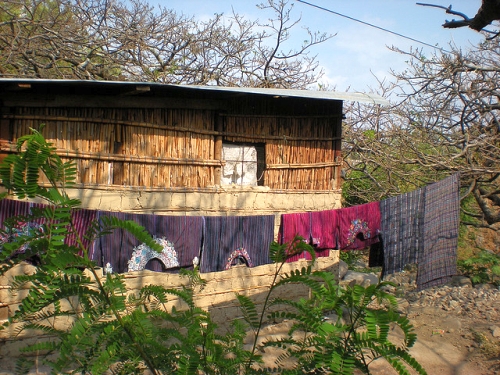
“It’s time, close your eyes,” says Keith in his brown cords and crumpled t-shirt. “Imagine a ball of light. Smile until it becomes real. Oh, the energy here is so beautiful today. Can you feel it?” He has such a kind, slow voice. I listen, I smile.
“Send the rays of light to someone you love, someone you want to help.”
I think of my best friend and her new baby.
“Go to glow. There you are. They can feel the light, it’s working.”
Then Keith the Chocolate Shaman goes on to talk about how there are two things in the world, love and fear. The polar of fear is intimacy, and the polar of love is that “Hey baby, come over here” kind of lust, and I think I understand that much, but then he goes on to talk about pain bodies and empaths and all these cosmic words I’ve never heard before. I open my eyes hoping to find someone else who looks as lost as me, someone who I can smile at and roll my eyes with, but everyone is smiling benignly with their eyes closed and waving their crystals in the air.
Kurt the Sewer Rat is now sitting cross-legged on the floor, letting out funny “whoooots” and laughing as tears run down his weathered face. I’d already heard that as the cocoa opens our hearts, tears become the base of the chocolate ceremony. Crying into his tie-dyed onesie is the young, mohawked guy from yesterday who sang Bob Dylan under a shelter by the lake — badly. A kind-faced woman with grey hair in a schoolgirl bob howls from under her matted, lilac shawl in the corner. The atmosphere is as dank as the wet earth from which the cocoa beans grow and as heavy as the sound of the rain on the canopy.
Keith begins to single out individuals from his high wicker chair. His voice breaks when he talks with the sparrow girl who was chatting about shiny hair before.
“You’ve been misunderstood since before you were even born.”
She nods with her big sad eyes.
“You’ve always had so much love for everyone around you, wanted them to be happy, so you ate all their shit, their negativity, and no one ever noticed how hard it was for you to love so much.”
Her body shakes from tears as he continues. As Sparrow gets up on her tiny legs to cry in the bathroom, Keith sounds like he is about to cry as he goes around the other souls sitting in front of him. An American woman with a lined, humorless face blinks back tears as she tells Keith in the style of teenage girls around the world.
“I met the first guy I’ve loved in so long, but we can’t be together. I don’t know how I can get through this pain, I just, I just can’t, it hurts so much.”
“He’s scared of your power, you’re such a strong woman,” Keith responds.
Everyone nods. As he continues and the crowd’s nods get stronger, I want someone to jump up and say, “You’re too good for him, girlfriend!” Instead, a sexy hippie girl goes to the broken woman in the corner and waves crystals around her aura. Is the chocolate ceremony just glorified group therapy?
Keith moves on and tries to heal more people. The good-looking older woman who doesn’t wash her hair gets extra special attention. Keith circles the top of her breastbone with one long finger and says, “Let it out, let it out.” She closes her eyes and breathes in deeply, I try the same.
Before I even open my eyes, I know it’s him touching my knee as a fuzzy buzz passes through my whole body. I look into his watery blue eyes and he begins to speak to me in his ancient voice.
“You’ve always had to be a good girl, always a good girl, no one ever wanted to see your heart, your creativity. You had to keep it in, didn’t you?”
I nod, feel tears in my eyes, but I cannot cry.
The Chocolate Shaman would say it’s because I fear breaking through to real happiness. I say I’m sick and tired of this strange, moody place. I say I’m envious of the others at the ceremony who seem able to feel so much more than me. Still, I’d rather laugh until I cry than be here right now.
I look back at Keith and say, “I’m leaving. Sorry.”
By Ailsa ross
[Lake Atitlan by archanas/Flickr; San Marcos by John Barrie/Flickr]

About the Author
 Scottish writer Ailsa Ross is sure she would be a wilderness explorer if she wasn’t so scared of the dark. Most of her adventures take place inside her head, and occasionally abroad, which you can read about over on DreamingOfArgentina.com.
Scottish writer Ailsa Ross is sure she would be a wilderness explorer if she wasn’t so scared of the dark. Most of her adventures take place inside her head, and occasionally abroad, which you can read about over on DreamingOfArgentina.com.
The post My Encounter With Keith, The Chocolate Shaman Of Guatemala appeared first on The Expeditioner Travel Site.
]]>The post How To Help Invest In The Future Of Guatemala appeared first on The Expeditioner Travel Site.
]]>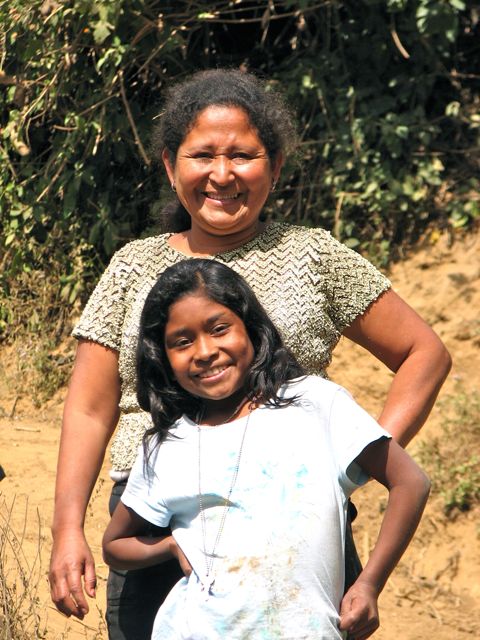
In the current presidential election there is a lot of talk about safety nets. Without being political, I’ll say that the most in the developed world have them, and they tend to be pretty effective overall.
In the third world, these nets often don’t exist, or are filled with human-sized holes. What this means is that when things go bad, they get worse and the sinking often doesn’t stop until things hit rock bottom. Rock bottom may mean homelessness, disease or, at the severest, loss of life. This is nothing new. The sick often become poor and the poor often get sick.
People at the bottom rung of the economic chain live day-to-day doing whatever they can to survive. On a bad day they might earn nothing; on a good day maybe they’ll earn $10. In my experience working with these populations, I’ve seen that the same family one month might earn $100 and the next month earn $300. What those two months have in common is how much is left over at the end of it: typically nothing.
The reason is often the result of lack of financial education. The poorest populations typically have little by way of experience handling finances. For many who are able to save, money is likely to be stashed in a mattress where it is vulnerable to thieves. The poor, more than any other population, would benefit dramatically by having a meager savings to help them over rough months when they don’t earn enough to even properly feed themselves or provide for needed medicine or school supplies. I’ve encountered families who chose not to send their kids to school simply because they couldn’t afford $20 in school supplies.
In the development field, most would agree that for many poor people with some regular income, having a savings would benefit them greatly. The question that results is: How do you do that? How do you get people with no financial education to learn how to manage their finances?
In Guatemala The Integral Heart Foundation is currently micro-testing an answer to this question by implementing a pilot project called The Third World Savings Project. The project consists of three simple parts:
1) Teaching impoverished families who have had no formal education how a bank savings account works.
2) Pairing them up with a mentor (local Guatemala university students), who can help them understand their finances better and make better financial choices.
3) Opening a bank account with them and then offering them the following incentive: If they make a deposit of any amount every week for six weeks in a row, $50 will be deposited into their savings account.
The end goal of this project is to help participating individuals see the value of having the safety net of a savings account and continue to use their new account. Even if 10% of the families in the pilot program continue after the pilot period, the program could be considered a success.
So will it work? We’re not sure. But we’re excited to find out and to learn how this idea pans out in the real world.
And this grassroots program needs your help. We are looking for 10 sponsors to sponsors 10 families in order to fund the program. If you are able to be one of them, please click here to learn more and help rewrite the rules of the game for one poor family in Guatemala.

About the Author
 After setting out to hitchhike from Chile to Alaska, Luke Maguire Armstrong stopped in Guatemala where he spent four years directing the social service programs of the charity Nuestros Ahijados. He is the curator of the high energy humor site Rabble Rouse The World and his book of poetry, iPoems for the Dolphins to Click Home About (available for sale on Amazon.com) is especially enjoyed by people who “don’t read poetry.” Look for his next poetry book, “How We Are Human,” this fall, and his novel “How One Guitar To Save To World” whenever he finally finds an agent.
After setting out to hitchhike from Chile to Alaska, Luke Maguire Armstrong stopped in Guatemala where he spent four years directing the social service programs of the charity Nuestros Ahijados. He is the curator of the high energy humor site Rabble Rouse The World and his book of poetry, iPoems for the Dolphins to Click Home About (available for sale on Amazon.com) is especially enjoyed by people who “don’t read poetry.” Look for his next poetry book, “How We Are Human,” this fall, and his novel “How One Guitar To Save To World” whenever he finally finds an agent.
(Follow Luke on Twitter: @lukespartacus).
The post How To Help Invest In The Future Of Guatemala appeared first on The Expeditioner Travel Site.
]]>The post Check Out Our Interview With QiRanger About Guatemala [Podcast] appeared first on The Expeditioner Travel Site.
]]>This week I and TheExpeditioner Managing Editor Luke Armstrong sat down (virtually) with writer/Korean podcaster QiRanger (aka Steve Miller) to chat about travel in Guatemala, which you can here in the above clip.
There is a discussion of what to eat while there, the best ways to travel about the country and maybe even a little talk about your likelihood of perishing at the fickle hands of the very active volcano gods that dot the country’s landscape.
[Tombs, a Run, and Guatemala – The QiRanger Podcast S3-05]
The post Check Out Our Interview With QiRanger About Guatemala [Podcast] appeared first on The Expeditioner Travel Site.
]]>The post The Expeditioner’s Travel Guide To Guatemala (HD) appeared first on The Expeditioner Travel Site.
]]>By Matt Stabile

ABOUT THE AUTHOR
 Matt Stabile is the founder and Editor-in-Chief of TheExpeditioner.com. You can read his writings, see his videos, purchase the book he co-edited or contact him via email at any time at TheExpeditioner.com. (@TheExpeditioner)
Matt Stabile is the founder and Editor-in-Chief of TheExpeditioner.com. You can read his writings, see his videos, purchase the book he co-edited or contact him via email at any time at TheExpeditioner.com. (@TheExpeditioner)
The post The Expeditioner’s Travel Guide To Guatemala (HD) appeared first on The Expeditioner Travel Site.
]]>The post Pleasure And Necessity: Expats Adrift In Antigua, Guatemala appeared first on The Expeditioner Travel Site.
]]>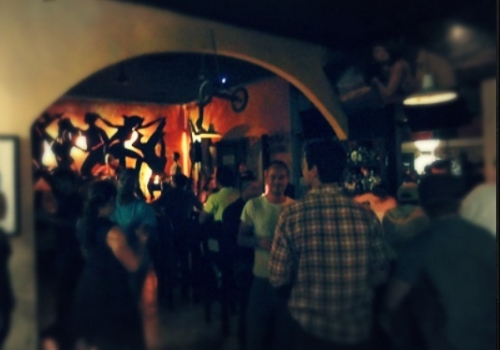
“Hop on! Just make sure you don’t burn your leg on the exhaust.”
I straddled the back third of the scooter seat behind my newfound gringo and gringa companions, Luke and Leta, and started looking for a bar or something to grab onto.
“Put your hands around my waist, no need to be shy,” Leta told me. Hearing that from an adorably freckled 20-year-old girl with bright blue eyes let me know that my night was beginning fortuitously, even if she meant it in a prosaic, crowded-scooter kind of way.
“We have to make a beer run first, hope you don’t mind,” Luke said. Or at least that’s what Leta relayed to me — I couldn’t make out most of the syllables from the front of the bike.
The jaunt to the convenience store was a short one but I was already enjoying the cool night air and the stares from the Guatemalan and European tourists heading to the bars and restaurants near Parque Central. We passed a Guatemalan police officer.
“You’re actually not even allowed to have two people on one of these,” Luke told us. “It’s to prevent drive-bys.”
Huh. I wasn’t surprised. I had just spent the week working in Guatemala City, one of the most dangerous cities in the Western Hemisphere. I actually enjoyed my time in Guate (GWA-tay), as locals call it, but the tension was undeniable. Guatemalans were constantly warning me to be careful, and I saw plenty of evidence that the warnings were justified. Nearly every storefront had an armed security guard, most of whom looked like nervous high school students. Every day, newspaper articles piled multiple murder stories into one big article, kind of like the morning fútbol round-up, except with more scoring. Several people mentioned to me that in 2009, more Guatemalan civilians were shot, stabbed or beaten to death than in the Iraq war zone. Ninety-seven percent of all murders in Guatemala go unsolved.
I was able to report my story without a single gunshot wound and didn’t have any other problems with crime, but the stories of kidnappings and roadside robberies had made me feel a bit paranoid, and I was looking forward to decompressing in Antigua before the flight back to New York. I had asked Matt Stabile, the editor of this website, whether he was interested in a story from Guatemala, and he recommended I get in touch with Luke Maguire Armstrong, a russet-headed friend of his who also contributes to The Expeditioner. A few e-mails and text messages later, I was riding caboose on Luke’s scooter, bouncing over cobblestones. As for Leta, she was a couchsurfer from Upstate New York passing through Antigua on a six-month trek through the Americas.
Luke put on his rounded helmet, looking like a dreamt-up spaceman from a bygone era, and we wobbled and swayed our way out of the busy, central part of Antigua. After maneuvering through a few quieter streets, we eventually reached an empty dirt road flanked by dense tropical brush; the headlight illuminated flashes of atavistic hunter greens and impudent harlequins. The beers were in cans and didn’t clang around too much on the rough terrain.
We reached a gated community and Luke spoke to an armed security guard in accented but competent Spanish. The guard wrote in a book quite deliberately for a few awkward minutes and then let us in.
“How do you two know each other?” Maggie asked Luke and me after inviting us inside. She was another gringa abroad, a friend of Luke’s, and was hosting us at the one-story house that she rented along with two Salvadoran twin brothers, one of whom she was dating. It had a stone fountain in the middle of the living room, a fireplace, big bedrooms and lots of reassuring bars on the windows, not to mention a couple of goofy-looking boxer puppies tromping around. I had to ask the inevitable question that New Yorkers ask everyone else in the world.
“We pay about $500 a month between the three of us,” Maggie told me. Did I mention that she had the muscle tone and firm personality of a capoeira instructor? At that point, I was finishing my first tall boy and feeling dreamily observant.
As I’ve done many times before, in places like Milwaukee and New Jersey, I proceeded to rant about just how ridiculously cheap her rent was, and how the apartment looked like the type of place that one could settle into and write a novel.
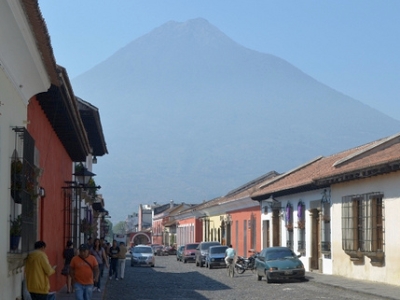 “It’s not that cheap when you’re working down here, earning Guatemalan money,” she said. “I’m bartending, so I basically make enough to cover rent.” I was already disconnected from any empathy I might have felt toward her situation.
“It’s not that cheap when you’re working down here, earning Guatemalan money,” she said. “I’m bartending, so I basically make enough to cover rent.” I was already disconnected from any empathy I might have felt toward her situation.
“I mean, if you could sell one or two freelance stories a month, you could live pretty nicely down here,” I said to no one in particular. “Jesus, my apartment looks like a fucking prison cell next to this place. You’ve got a fucking fountain in your living room.”
I never really got over the rent differential, but with a second beer, I at least turned my attention to other things. Luke had located two out-of-tune classical guitars and he handed me one.
“I don’t know how good those will sound,” one of the brothers said. I wish I could remember their names, but the truth is that I can’t even remember Maggie’s name; I made it up.
Luke tuned his guitar first. We didn’t have a tuner, so he used his ear. I imagined him harnessing an airy melody from the mountains surrounding Antigua. Once he was tuned up, I followed suit, siphoning a low E note, and then tuning the other strings against that. I wondered if the rest of the party – los gemelos, the fit girl, Leta – were dreading the unknown sound that the two of us would generate with these crippled instruments. But I didn’t care. All I wanted to do was play.
Luke began with a gentle, finger-picked ballad, over which I played accompaniment. I was grateful that he had a repertoire of songs to drawn on. We played a few more like that – Luke strumming the rhythm and singing, me adding fill. I overheard Maggie gathering everyone to leave for a bar as Luke started strumming what I figured would be the last song.
It sounded like an Irish pub song, and Luke sang some powerful vocals, the kind that are normally primed by years of drinking whiskey and not by a can and a half of Central American beer, but his voice sounded firm. We played it to its fullest for three verses and choruses, and then responsibly wound it down to a conclusion. Finished, we exchanged a look of mutual satisfaction. It was as if we had entered an acoustic brotherhood.
*
Outside, conversation shifted to the security situation in Guatemala, a thematic discursion likely prompted by the bars on the windows and the dude at the front gate wielding heavy artillery.
“Our friends were robbed,” Maggie said. “Even apartments with bars and security guards still get break-ins.” Someone gave me a cigarette and my buzz increased exponentially.
After another motorbike ride, the night continued at a rooftop bar: drinks, people, more conversations. The mountain air felt like aloe vera on my skin after the raw heat of Guatemala City. Once the party disbanded, Luke, Leta and I ended up back near where we started, sharing a bench in a now-sedate Parque Central.
“So you met Saul Kripke?” Luke asked me.
Actually, I had met Kripke. His name is pronounced “Crip Key.” I was working on a story for Time Out New York magazine about philosopher hangouts in NYC and I somehow ended up on the horn with a well-known art critic and philosopher whose name escapes me. He told me that Saul Kripke was one of the most famous philosophers in New York City. I gave Crip Key a call.
We met at Le Pain Quotidian a week or so later. I had never been there and, honestly, it seemed pretty lame. Kind of like a slightly cleaner Au Bon Pain and I’m sure I’m not the first to make that comparison. I was running late and I had to take a cab, which cut into my already insignificant paycheck. I decided I would only order a tea and wait for him to pick up the check.
Kripke was there, white haired, white bearded, and scrunchy-faced like a baby smelling pepper for the first time. He had a handler next to him, a beautiful young woman in her early 30s, possibly French or Israeli. Judging by how she manhandled philosophical jargon, she must have been an upper level graduate student, although she also appeared to have the kind of intimate knowledge of her employer’s life that you might expect from a personal assistant. Or maybe she was his wife or his daughter, what the hell do I know? They were sitting at an unvarnished table, a signature part of Pain Quotidian décor.
I was late for the meeting because I have a tendency to be late for things, but also because I had been doing some research on Kripke. I thought I had at least a common man’s understanding of philosophy, but Kripke’s stuff made no fucking sense at all. And I was only reading the Wikipedia entry.
Here’s one of his best quotes, according to Google Books:
Humphrey might have won the election (if only he had done such-and-such), we are not talking about something that might have happened to Humphrey, but to someone else, a “counterpart.”
On the topic of philosopher hangouts, Kripke didn’t have much to say. Actually, he seemed to object to the very premise of the interview, repeatedly telling me in a high-pitched and nasal but melodic voice, “I don’t really do anything all that interesting.”
He technically didn’t even live in the city. I think he had a place on the Upper West Side but he lived in Princeton and commuted a couple times a week. He seemed worried about the kind of piece I might write. I reassured him that the article would be of little interest to anyone. After about 30 minutes of haphazard chit-chat, he gave me the name of a supermarket in Princeton as one of his hangouts. I told him that it needed to be in the city.
“Oh, but I hardly ever go anywhere in the city. Sometimes we come here.”
I conceded that I’d have to eat the cab fare on this one, and then said goodbye to Kripke and his lovely Israeli/French sidekick.
*
Luke, Leta and I on the bench.
“Yeah, I met Kripke. Kind of a strange dude, but I guess even if his work is unintelligible it’s because of his level of genius.” And then I told them the story of Kripke.
I woke up the next morning with a legitimate hangover, but feeling the high that comes after a night full of pleasant surprises. I looked at the clock on my Guatemalan cell phone. Just after 10 a.m. Luke was supposed to be hiking a volcano. What a vigorous young man — my goal was brunch.
I showered, grabbed a newspaper and a bottle of water, and returned to the park, where I was supposed to meet Leta.
I haven’t said much about her. She was a bit of a hippie in disguise — a Marxist in J. Crew. The night before, she sat between Luke and me on the park bench with one knee hugged to her chest, saying how amazing it was to meet the two of us on the same day. After some degree of inner reflection, I decided I would participate in a threesome if that was what she was implying, but I knew it wasn’t.
“Sorry to keep you waiting, Luke just dropped me off,” she said. She looked limpid in a breezy dress and flip-flops. We grabbed some breakfast at an upscale Guatemalan café trafficked by tourists and weekenders from Guatemala City. I learned about Leta.
You meet a certain type of gringo backpacker in Latin America. Unlike in Europe, you don’t seem to run into study abroad students. Depending on the country, you won’t even encounter too many other American travelers (expect Kiwis by the jolly dozen). But the expat backpackers you do meet tend to speak Spanish, intoxicate freely and consider socialism a valid – if not necessary – form of government. They may or may not have dreadlocks, but in all cases, they respect people who do. In other words, these are cool folks.
Leta was no exception. After brunch we returned to Parque Central and passed more time on a bench. The plaza was still bustling.
“Tengo Biblias! Se vende Biblias!” A little boy — maybe eight years old — yelled, trying to sell Bibles in the square. Oddly, we had been talking about God, or the lack thereof, a little while before. The boy sat down on the bench next to Leta.
“Tengo Biblias,” he said halfheartedly. His gaze was fixed absentmindedly across the square. Apparently he didn’t sell a lot of these, or at least he wasn’t concerned with sales tactics.
“No creo en Dios,” Leta told him. The bluntness of her comment caught him like a slap in the face. He looked dazed.
“¿Y usted. Cree en Dios?” he asked me. “Sí,” I told him, even though the answer is probably more like, “I wish.” In a country where you could never have too much Jesus paraphernalia, I didn’t want to be the asshole who killed Santa Claus on a bright Saturday morning.
Leta was meeting with a friend later, and she pulled out an iPhone that she used for picking up WiFi. I can’t remember if she was actually checking the phone or just playing with it, but at least it shifted our conversation away from the absence of a benevolent deity.
The boy, his name was David, didn’t seem to be too familiar with the iPhone, and she showed him how the touch screen worked. He asked how much it was worth, and when she told him, in quetzales, I thought about how many Bibles he would need to sell to make that much money.
“¿Tu peso?” David asked. In addition to the Bibles, he had a scale that he carried around so that people could get an up-to-the-minute heft assessment. I told Leta she should try it, but in the end we both passed. David stayed with us a while longer on the bench, then decided to continue working the square.
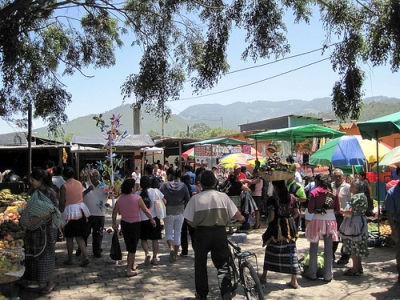 Leta and I took a walk to a nearby craft market that catered to tourists who were looking for something a little nicer than what you might find on the street. We walked into an open-air courtyard surrounded by stalls, and strolled from stall to stall, considering an occasional trinket: earrings, necklaces. I was looking for something for my girlfriend.
Leta and I took a walk to a nearby craft market that catered to tourists who were looking for something a little nicer than what you might find on the street. We walked into an open-air courtyard surrounded by stalls, and strolled from stall to stall, considering an occasional trinket: earrings, necklaces. I was looking for something for my girlfriend.
“I believe in polyamory,” she said. “I don’t think you should have to be with one person just because that’s what society tells you to do.” She went on to explain polyamory to me. I actually didn’t know exactly what it was. And, yes, I wanted to hear her talk more about it, and even see it in action, if possible. “I had this amazing sociology professor and I was talking to him about dating guys, and how I felt about it, and he said, ‘Maybe you’re polyamorous.’ And I think I am. It really does make more sense.”
Of course it does. At least to every guy in the world, including your professor, I thought. But let’s stay away from sexist stereotypes and listen to Leta talk about polyamory.
“This isn’t about sex. I only have sex with one guy. It’s about relationships. There are things that some guys can give me that others can’t, and vice versa. I may want to spend time with a guy, and really enjoy his company, but not fuck him. That’s how polyamory works.”
I was a little surprised/disappointed that her philosophy wasn’t pegged around casual and exhaustive sex, but she certainly had a good point.
We finished perusing the crafts and she offered to take me over to another market, one where locals shopped. It wasn’t far away. We approached some fruit vendors with big baskets of mangos, papayas, guavas and avocados, as well as loads of other fruits I didn’t recognize. We walked between the vendors into an indoor market, a conglomeration of simple wooden stalls covered overhead by corrugated metal panels. We passed people selling all types of foodstuffs: spices out of open sacks, fish, Guatemalan pastries. The walking lanes were narrow and crowded.
There may have been other gringo tourists, but if so, I didn’t see them, and the market didn’t seem particularly geared toward out-of-towners. Mostly people were selling essentials. The vendors were grouped in sections. After the food, we passed through an area where people were selling wooden chairs, followed by an area with electronics, and an area with clothes.
I was running low on clean laundry and bought a pair of socks with the word “UMBRO” stitched into the fabric; the price was negligible by US standards. I got the impression that Guatemalans from more rural areas around Antigua traveled into town on Saturdays, or maybe every day, to sell their wares at this market. Labyrinthine would have described it, and after five minutes of shuffling from stall to stall amid the crowds, I felt the intoxication of the minotaur’s prison, at once amazing and overwhelming.
In an area that could have been the center of the maze, we found some eateries serving traditional Guatemalan dishes. The mini-restaurants were lined up one after the other, people cooking more or less in the open, and a few picnic tables and benches where you could sit down and eat. We found an open table and ordered the menu of the day, soup and fried chicken. I ordered a Coke.
“My problem is that I’ve been dating the same girl for years, but I still don’t want to get married,” I told Leta. “I feel awful. I know she wanted that years ago, but I’m just not ready. I tell myself that I might be ready eventually, but when I think about it, I just can’t believe that will be the case.”
“Then why are you still doing it?”
“It’s complicated,” I said. “We should probably break up, but it’s not that easy.”
A young lady brought my Coke and a glass of ice.
“Should I drink this with the ice?” I asked Leta, afraid of the consequences of drinking unfiltered water. “I’d rather not drink it warm, and they already put ice in the glass.”
“Just drink it, you’ll be fine,” she told me.
By Ted Hesson
[Guatemala by Marina Villatoro/Flickr; Remaining photos by Matt Stabile]

About the Author
 Ted Hesson is a multimedia editor and producer based in Manhattan. For more of his work, visit TedHesson.com
Ted Hesson is a multimedia editor and producer based in Manhattan. For more of his work, visit TedHesson.com
The post Pleasure And Necessity: Expats Adrift In Antigua, Guatemala appeared first on The Expeditioner Travel Site.
]]>The post 14 Unforgettable Images From Guatemala appeared first on The Expeditioner Travel Site.
]]>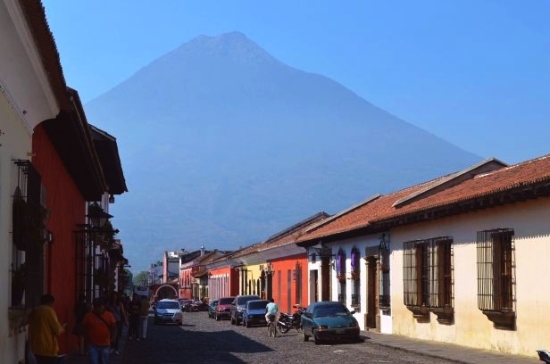
At 12,336 feet, Volcán de Agua towers over Antigua, which was once the capital of the country until 1773 when a massive earthquake struck destroying much of the country.
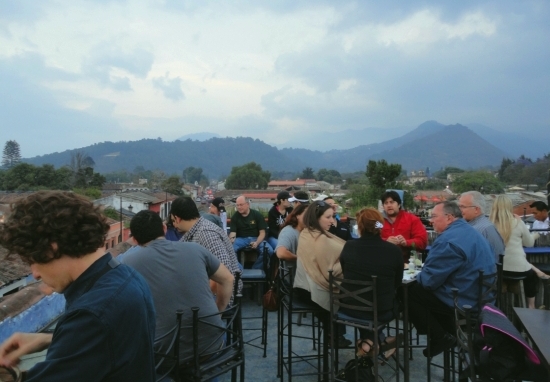
Antigua’s population is only about 30,000 people, but during the height of the tourist season that number swells to over 60,000, many of whom are there attending one of the 80 or so Spanish schools located in town.
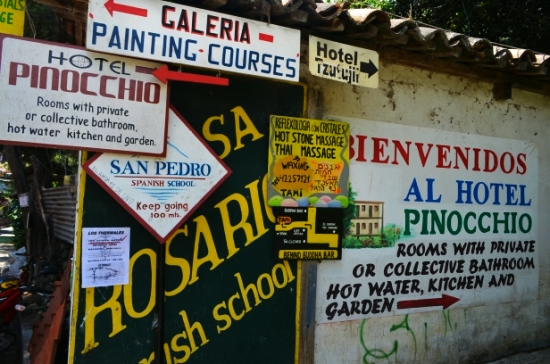
San Pedro La Laguna, on the southeastern banks of Lake Atitlán, is at once an expat hippie hangout, a weekend getaway for locals, a destination for backpackers and a long-standing Mayan village dating back long before the Spanish arrived.
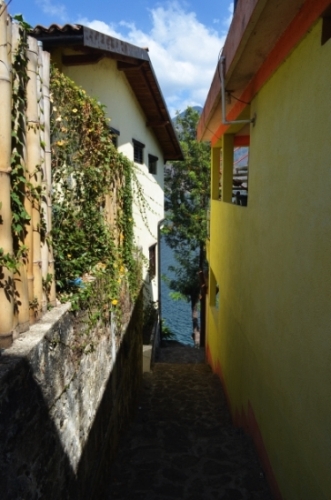
The town is marked by narrow roads and winding alleyways, especially fun to navigate when storms roll in and the electricity goes out, which is a frequent experience.
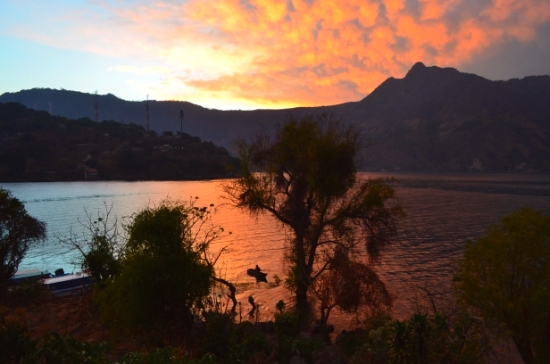
“Lake Como, it seems to me, touches the limit of the permissibly picturesque; but Atitlan is Como with the additional embellishment of several immense volcanoes. It is really too much of a good thing.” Aldous Huxley from Beyond the Mexique Bay, 1934.
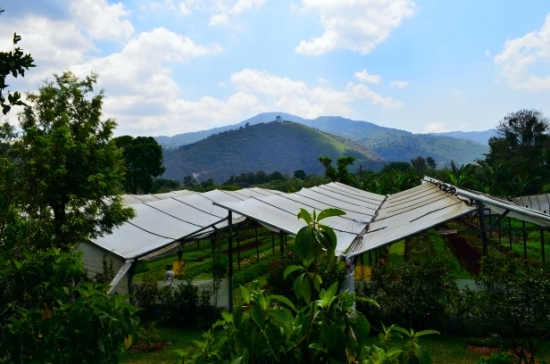
Caoba Organic Farm, just south of Antigua, is both a purveyor of organic food to the town’s local restaurants as well as a laboratory for sustainable, healthy farming techniques that can hopefully be reproduced by local farmers in the region, much of whom are dependent on chemical fertilizers and “feast and famine”-type farming practices.
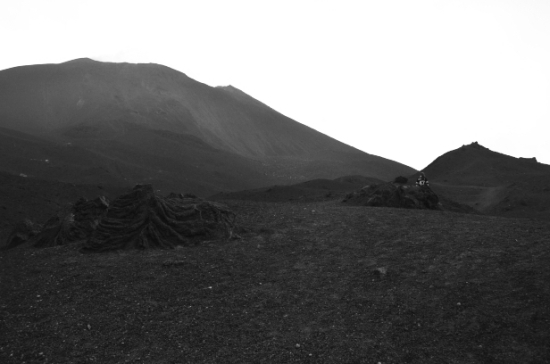
The black basalt earth near the summit of of nearby Volcan de Pacaya offers day hikers a moon-like landscape upon arrival.
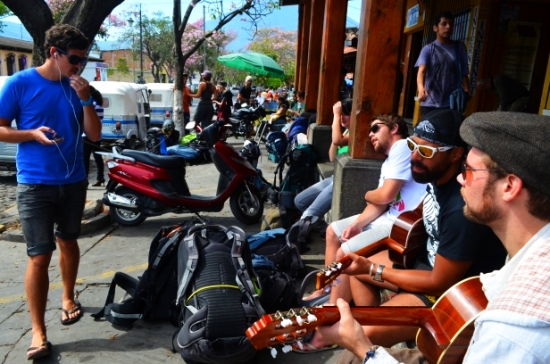
There’s regular time and then there’s Guatemala time. An 8 a.m. departure via mini-bus can easily result in a three-hour jam session layover at the town’s market while paperwork is sorted out and registrations are renewed before leaving.
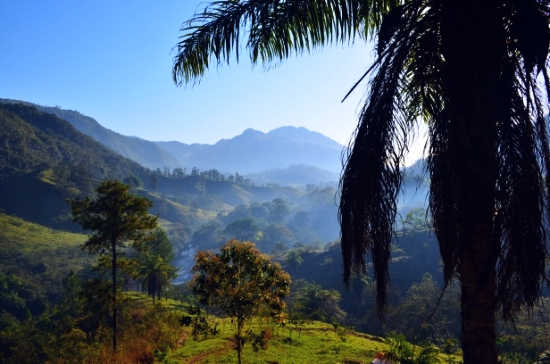
Located on a scenic ridge in Lanquín, Zephyr Lodge offers unparalleled views of the surrounding hills. Despite the amazing scenery, the real attraction here is nearby Semuc Champey, where hiking, cave exploring, bridge jumping and natural pool lounging all come together for an incredible experience.
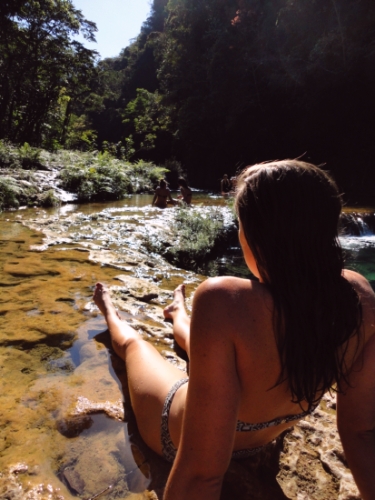
Above the Cahabòn River at Semuc Champay is a series of naturally occurring turquoise pools where visitors can lounge in the water, dive into deep pools and slide down rock slides into parallel basins.
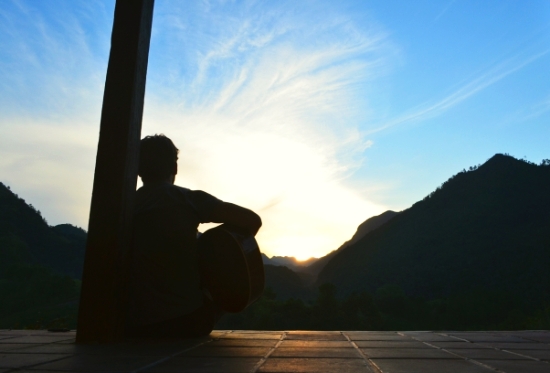
The sun sets early in Lanquín as a result of the towering hills surrounding the valley. The impending cool air is a welcome respite from the day’s sweltering heat.
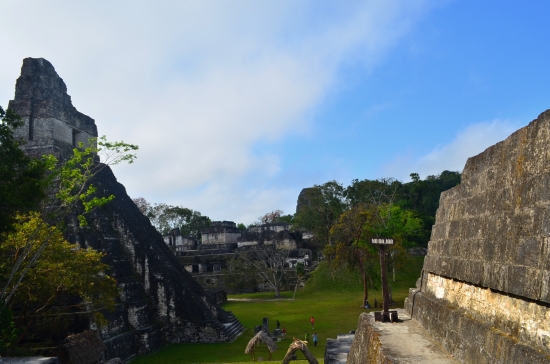
Tikal is located in the department of Petén, in northern Guatemala, and was once the capital of the most powerful Mayan kingdoms.
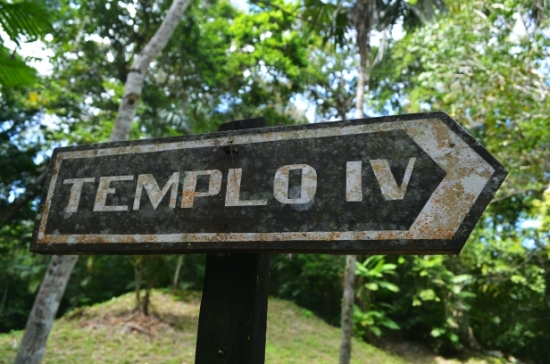

At 212 feet, Temple IV is the highest building in Tikal, and offers the best views of the surrounding area.
By Matt Stabile

About the Author
 Matt Stabile runs TheExpeditioner.com. You can read his writings, see his videos, purchase the book he co-edited or contact him via email at any time at TheExpeditioner.com.
Matt Stabile runs TheExpeditioner.com. You can read his writings, see his videos, purchase the book he co-edited or contact him via email at any time at TheExpeditioner.com.
The post 14 Unforgettable Images From Guatemala appeared first on The Expeditioner Travel Site.
]]>The post The Visa Run Diaries appeared first on The Expeditioner Travel Site.
]]>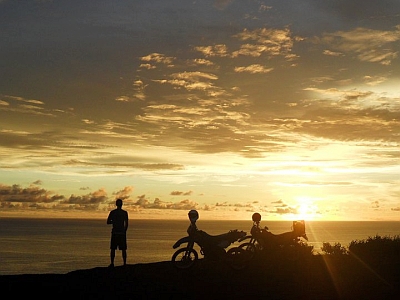
What would Che say?
Perspiring at a rate that suggests total disintegration is imminent, the police officer wiped another sweat globule from his a forehead.
“Where are your papers?” he asks.
With nostrils floating in a sea of rubbery flesh, shirt buttons straining against a bloated paunch, the overall impression is one that makes me think back to Mr Ward and his production of Animal Farm in sixth grade where my drama teacher found it difficult to transform human children into convincing representations of authoritarian Orwellian livestock. This guy would have been an absolute inspiration.
“Your papers!'”, he insists again.
Silence. We look at each other with expressions that we hope suggest “innocent tourists harmless and confused in a foreign land,” but it’s a card we’ve been playing for about six or seven minutes now and pig-boy is getting agitated. Itching for a bribe, he and his less mean colleague — the universally prerequisite good-cop — nabbed us as we were traveling helmet-less on our way to find a watering hole.
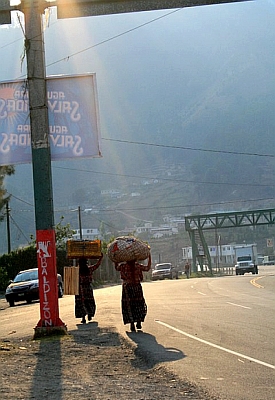 We’d just entered Nicaragua from Costa Rica and had, evidently prematurely, been reveling in the freedom that being back in “the real Central America” afforded us. Our state of lawless abandon having betrayed us, we were now trying to avoid paying a penalty to the Tweedle-twins estranged third sibling. Even more frustratingly, as we stood defending our honor and our wallets on the dusty pavement, great swaths of the population were passing by entirely helmet-free, flagrantly enjoying the sensation of the wind through their hair and warranting no attention from our diligent crime-fighting duo. Fundamentally, we looked like we had a lot of cash and little idea.
We’d just entered Nicaragua from Costa Rica and had, evidently prematurely, been reveling in the freedom that being back in “the real Central America” afforded us. Our state of lawless abandon having betrayed us, we were now trying to avoid paying a penalty to the Tweedle-twins estranged third sibling. Even more frustratingly, as we stood defending our honor and our wallets on the dusty pavement, great swaths of the population were passing by entirely helmet-free, flagrantly enjoying the sensation of the wind through their hair and warranting no attention from our diligent crime-fighting duo. Fundamentally, we looked like we had a lot of cash and little idea.
Presumably then, apart from getting hideously mauled in a traffic accident, it is because of situations like this that moms and dads are never going to be thrilled about you riding across five Central American countries on the back of a motorcycle with a cigarette in your hand and a bad man between your legs. Even if, in actual fact, you successfully negotiate brushes with the law, the man between your legs is actually very nice and the logistics of sucking on a cigarette while riding a bike at dangerously fast speeds defeat the intention. Trips such as this one remain something I endeavor to keep under the parental radar.
The purpose of the expedition was basically a visa run. In Guatemala, once you have been in the country for six months, it is compulsory for you to leave in order to renew your visa. Thanks to a rather annoying loophole where four of the Central American countries got together and decided to make life ”easier,” you cannot cross into one of Guate’s immediate neighbors in order to do so. Therefore, when I found out that my two friends, Matt and Chris, were heading down to Costa Rica for an Ultimate Frisbee competition (which is basically Quidditch for people who aren’t wizards), and would be riding back up through Nicaragua, El Salvador and Honduras with space for a passenger, I seized the opportunity.
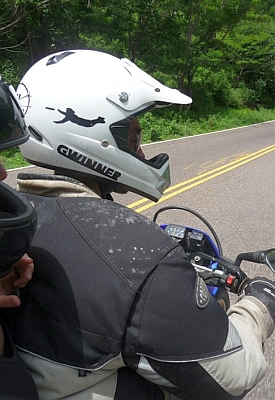 My journey down to meet the boys involved a series of buses, a night in San Salvador with the most depressing human being ever to walk the planet (who hailed, conversationally, from Texas and had a face that denied anatomical convention, in a bad way), two road blocks and a rather embarrassing incident where I was asked to unpack my underwear onto the side of a Honduran highway. By the time I arrived in La Fortuna, Costa Rica, I was glad to see the others. We celebrated with hot springs, rope swings and waterfalls.
My journey down to meet the boys involved a series of buses, a night in San Salvador with the most depressing human being ever to walk the planet (who hailed, conversationally, from Texas and had a face that denied anatomical convention, in a bad way), two road blocks and a rather embarrassing incident where I was asked to unpack my underwear onto the side of a Honduran highway. By the time I arrived in La Fortuna, Costa Rica, I was glad to see the others. We celebrated with hot springs, rope swings and waterfalls.
The next morning I squeezed my ample backside into the not-so-ample space behind Chris on the Yamaha and off we went. We’d only been riding along for about 15 minutes before the following and somewhat alarming question arose: “Where is Matt?”
I could see Chris anxiously searching in the mirror for our fellow rider. I think we were both more concerned as, shortly before, he had been pulling ridiculous wheelies, one of which narrowly avoided being fairly catastrophic, and had prompted me to remark – ever the maternal Nostradamus – that he was getting cocky and this spelled trouble ahead.
After continuing for another mile or so, we turned back, expecting any minute to see the lost adventurer motoring into view. But of our barelegged friend – he only ever drove in shorts – there was no sign, and my stomach was starting to knot. Even taking into consideration potential aerodynamic complications caused by his insistence on wearing a huge black daftpunk-esque hat, he should have appeared by now.
Around the next bend, we spotted something in the long grass at the edge of the road. It was a wheel or, more precisely, the wheel of Matt’s motorcycle; the wheel of Matt’s motorcycle which was now lying upside-down in the ditch. Bloody typical, I found myself thinking, he’s gone and killed himself before we’ve even started. This thought, however, was rapidly replaced by images of trying to retrieve his body.
As I was starting to role-play what I would say to his mother on the phone, thankfully, a disheveled figure emerged from the undergrowth, sporting scrapes and bruises but a wide grin. After making a few repairs to the bike which, at this point, seemed to have escaped without anything more than superficial damage, and with our morning’s near-death experience ringing in our ears, we set off (carefully) for the coast.
Every so often, especially when you travel, you meet people you feel are probably running away from something but, thanks to a process of dramatic geographical location, they have been able to start a new life for themselves, away from their questionable past. Jimmy, with his deep tan, wrinkled torso and young local wife, living out on Western Peninsular had the distinct air of an individual who had escaped prosecution for some fairly major criminal activity. Nevertheless, he was offering the cheapest rooms in the area, as well as small hot plates on his balcony available to guests for cooking. Ideal, as long as you didn’t mind parrots, dog hair, smoke or old Jimmy thinking you wanted to have sex with him.
 To give him his due, Jimbo was responsible for directing us to one of the best sunset spots I have probably ever been to in my life. Following his set of drawled instruction, we set off into the beckoning dusk, winding the bikes up a dirt road onto an abandoned headland. The sky out across the ocean was endless and clear, while behind us, mist from an afternoon storm lingered over a cloud forest. On either side the cliffs fell away down to the coast, the glorious light of the evening reflecting shimmering bays and bathing a range of mountains that stretched off into the silence of distant volcanic ranges in a supernatural luminescence.
To give him his due, Jimbo was responsible for directing us to one of the best sunset spots I have probably ever been to in my life. Following his set of drawled instruction, we set off into the beckoning dusk, winding the bikes up a dirt road onto an abandoned headland. The sky out across the ocean was endless and clear, while behind us, mist from an afternoon storm lingered over a cloud forest. On either side the cliffs fell away down to the coast, the glorious light of the evening reflecting shimmering bays and bathing a range of mountains that stretched off into the silence of distant volcanic ranges in a supernatural luminescence.
With all the gold light and general wonderment knocking around, I would not have been surprised to see Aslan emerging from the trees: this was proper Narnia shit. It also proved to be the perfect opportunity for some arty photography involving silhouettes and motorcycles. We posed around for a bit, before being completely consumed by nature’s display of pure majestic brilliance, the hypnotism of pantheistic reflection broken only by Matt and Chris playing “throw a stone at a cup.”
That night, the room smelled like ass-crack. Sweaty clothes getting wet and not drying meant that from this point onwards, not only would we would reek to high heaven but, thanks to muddy tracks and sooty highways, we looked like we’d just enjoyed a shag with a horny band of rogue chimney sweepers. It was also becoming increasingly apparent, as we continued to clock up the mileage, that Matt’s bike had suffered more critically in the wreck than we had initially expected, i.e., things were rapidly starting to fall off it.
As we rolled into Antigua, the ailing machine — already semi-impossible to start, as well as missing a kickstand, hand guards, etc… — became break-less. It really couldn’t have driven another inch. Yet, as my stricken companion gave some chat about logistics of wheeling the thing to a nearby workshop, I stopped listening. I was having a moment. Overwhelmed by a sense of deep satisfaction. I felt like a homecoming explorer. We had survived 10 border crossings, mountain passes, coastal roads and jungle paths. We’d faced the elements and emerged victorious. And, with skin now as weathered as a farmer’s elbow, we certainly looked the part. Perhaps not quite a journey of Guevara proportions, but a Motorcycle Diaries of our own.
Unfortunately, there was a distinct lack of hero’s welcome, the hoards evidently hadn’t gotten the memo on our triumphant return. So we went to get a sandwich. Which tasted like glory.
By Hannah Bowman

About the Author
 A restless Brit with big dreams and limited cash flow, Hannah is an English graduate and former Publicist who has spent the past 18 months living and working in Central America. She is currently back in the U.K. seeking the inspiration (and funding) for her next adventure.
A restless Brit with big dreams and limited cash flow, Hannah is an English graduate and former Publicist who has spent the past 18 months living and working in Central America. She is currently back in the U.K. seeking the inspiration (and funding) for her next adventure.
The post The Visa Run Diaries appeared first on The Expeditioner Travel Site.
]]>The post Lions And Lions And Mormons! Oh My! (Part 3 Of The Lion Trilogy) appeared first on The Expeditioner Travel Site.
]]>
Warning, if you enjoy reading about Mormons being mauled by lions, then keep reading . . .
For those of you who follow my Expeditioner posts (Thanks Mom, Dad and Roberta*) you may have noticed that my last two posts hinged upon a lion that mysteriously showed up in my neighborhood (“Lions, CouchSurfing and Murder”), then was mysteriously taken away by police shortly after it arrived (“Why They Took The Lion”).
This would leave Mom, Dad and Roberta to believe that there is no possible way I was going to continue to write about lions. Especially since in the last article the police came and took the lion away. With the lion gone, how could I possibly continue to write about it?
But just when I thought my lion writing days were over — BAM! — our friends at the Church of Jesus Christ of Latter Day Saints came out of nowhere to lob me a lion-fodder filled Hail Mary Pass and just like that, it´s game back on.
What happened serves as a lesson to travelers and zoo-goers everywhere: You´re a moron if you decide to jump into the lion pen.
Here´s the Church of Mormon’s official statement surrounding what happened this week in Guatemala to one of its missionaries:
Elder Paul Richard Oakey, 20, from St. George, Utah serving in the Guatemala Guatemala City South Mission was attacked by a lion when he stood too close to an exhibit at a local zoo while on a preparation day activity. He sustained serious injuries to a leg and arm and was rushed to a local hospital where he underwent emergency surgery. The doctors are still evaluating and assessing his condition. Our thoughts and prayers are with Elder Oakey and his family as he goes through this difficult time.
 When the Mormons say stood too close to an exhibit, what they really mean is that Elder Paul (who at 20 seems awful young to be an elder) climbed over a concrete wall to get a better picture of the lions. And if Elder Paul thought that his magic underwear would protect him, he was gravely mistaken.
When the Mormons say stood too close to an exhibit, what they really mean is that Elder Paul (who at 20 seems awful young to be an elder) climbed over a concrete wall to get a better picture of the lions. And if Elder Paul thought that his magic underwear would protect him, he was gravely mistaken.
A local ABC news affiliate interviewed Paul´s stepfather who explained what happened. “Paul stood with his back to the lions, one of them crept up and grabbed his right leg, pulling him against cage bars, where a second lion then grabbed and clawed at his arm.”
Paul spent a full two minutes being mauled by lions until he was finally freed and was taken to a local medical center for treatment where he was stabilized and will survive to soon continue his mission of convincing naïve Guatemalans to give up caffeine, which in coffee country is no easy task.
His stepfather went on to say, “Paul loves life . . .Regardless of his poor judgment in this case, he’s energetic, he’s healthy, he’s strong, he’s in good spirits, and it’s just another adventure for him.”
It certainly leaves one to wonder what adventures Paul´s poor judgment has in store for him next.
Could it be my lion?
When the police came and took lion from the circus that was staying near my house, one of the police officers told me was that they were taking the lion to live in the zoo in Guatemala City.
Could this mean that this lion, my lion, was the one who mauled Elder Paul? The answer is: definitely maybe. And definitely maybe adds another chapter in a story that just when I think it´s time to write, “THE END” continues to unravel and reveal more ridiculous layers.
Here is the part of the article where I was going to conclude things by launching into a safety tirade about zoos and traveling and how travelers should not jump into lion cages for the sake of snapping a good photo. But really, if you are the type of person who jumps into lion cages for the sake of a photo (and I include myself), then nothing I write here is going to dissuade you. My only advice to you is to be quick — be so very quick, like a hurricane forced wind and run like the dickens when you see the lion running towards you with a hungry look on his murderous eyes.
And Paul, never turn your back to a lion, magic underwear be damned.
THE END (Maybe)
*Roberta´s name has been changed to protect her identity and mine. But Roberta, you know who you are. You know that you are my creepy Guatemalan stalker who makes me very uncomfortable when you send me messages like, “Me gustía tomar café contigo, pero de verdad no quiero el café, me gustaría solo tomarte como un café para que te sienta en mi estomago . . .”
What the hell, Roberta? I have no idea what you mean when you say that, but I know it´s meant to be sexual and I know it makes me uncomfortable, and I don´t know who gave you my phone number (was it Matt Stabile?), but you need to stop calling and writing me.

About the Author
 Luke Maguire Armstrong lives in Guatemala directing the humanitarian aid organization, Nuestros Ahijados. His book of poetry, iPoems for the Dolphins to Click Home About (available for sale on Amazon.com) is especially enjoyed by people who “don’t read poetry.” (@lukespartacus)
Luke Maguire Armstrong lives in Guatemala directing the humanitarian aid organization, Nuestros Ahijados. His book of poetry, iPoems for the Dolphins to Click Home About (available for sale on Amazon.com) is especially enjoyed by people who “don’t read poetry.” (@lukespartacus)
The post Lions And Lions And Mormons! Oh My! (Part 3 Of The Lion Trilogy) appeared first on The Expeditioner Travel Site.
]]>The post Why They Took The Lion appeared first on The Expeditioner Travel Site.
]]>“They are taking the lion to the vet, because he is sick. He is merely sick.”
“We are taking the lion to live in the zoo in Guatemala City because they have kept him in inhumane conditions.”
“They are taking the lion because they have a court order to take the lion.”
“We are taking the lion because they do not have a permit to have the lion.”
“They are taking the lion because they have been looking for the lion for three years. The lion is a stolen lion.”
On June 20, 2011, the lion left as strangely and unexpectedly as he had come.
The lion arrived on a Monday. He came alone. The morning started off as an otherwise nondescript morning. The gate guard in my gated, Guatemalan community made a variation of the same comment he had been making for months. “Luke, I have a raccoon. But this one bites the face, not the legs.”
“Good,” I responded, feigning seriousness. “Lend me this raccoon so that I can kill it.”
The gate guard bellowed a deep chuckle and waved me through. A few months before I had shown the guard the wounds in my legs from a raccoon attack, and since that date, this was the recurring topic of our conversations.
As I drove out of my neighborhood to work that morning, a cage containing a lion was sitting in the center of the vacant lot behind my house in Jocotenango, Guatemala. This was unusual, even for here. Despite living here for three years, strange occurrences and cultural conundrums continue to baffle me. In Guatemala all roads lead down the murky road of mystery.
The afternoon after the morning of the lion’s appearance, an entire circus started setting up and the lion’s presence in the vacant lot soon made sense. He was merely the first arrival of “The Jordan Bro Circus.” A sign outside advertised a dozen marvels that included suicide trapeze artists, a magic midget and a lion-riding monkey. I soon became a loyal audience member.
The beauty of circuses in this part of the world is the real sense of danger accompanying every wondrous act. You feel that people might get killed. It’s not that you want people get killed, but the over-50-year-old equipment and complete lack of regulation cultivates a tingling tension in the audience.
If you have ever wanted to see a monkey ride a lion, the Jordan Bro Circus is where you can. Or, I should say, it was where you used to be able to see it. They took the lion away.
Three Mondays after the circus came, a mob had gathered outside the circus tent. Over 30 police officers and military men were stationed around the circus tent armed with Rambo-sized guns. I had never seen so many police officers in one place and assumed something big must be going down.
“What’s going on?” I asked one of the onlookers.
“They are taking the lion,” she said.
I rushed to my house and told my photographer roommate to grab his gear to capture the moment. My parents, who were visiting me from North Dakota, rushed with us to the scene. I recognized a dozen reporters amongst the onlookers and asked one why they were taking the lion. “They are taking the lion because they have been looking for the lion for three years,” he told me. “The lion is a stolen lion.”
The sad clowns were extra sad that night. They were out of costume, but bits of white makeup still lingered on their faces. I asked one why they were taking they lion. “They are taking the lion to the vet, because he is sick. He is merely sick.”
 As a man walked out of the blocked-off circus tent with a large tranquilizer gun, a policeman motioned for everyone to back up. The man with the dart gun had a private spark of joy on his face. He breathed deeply and seemed to inhabit a world very far from the present one. He looked out at us and seemed saddened that we would never know his joy. And how could we — those of us who had never shot a lion with a massive tranquilizer gun –ever understand the world as he did?
As a man walked out of the blocked-off circus tent with a large tranquilizer gun, a policeman motioned for everyone to back up. The man with the dart gun had a private spark of joy on his face. He breathed deeply and seemed to inhabit a world very far from the present one. He looked out at us and seemed saddened that we would never know his joy. And how could we — those of us who had never shot a lion with a massive tranquilizer gun –ever understand the world as he did?
The circus announcer came out and told the press that they could not take pictures. The press merely pressed forward, unaffected by his insistence. I motioned for my roommate to move forward and our height, which towered over the shorter crowd around us, gave us excellent vantage points.
Everyone tensely anticipated the same thing. The lion is coming!
I asked one of the police officers why they were taking the lion. “We are taking the lion to live in the zoo in Guatemala City, because they have kept him in inhumane conditions.”
A shabby Toyota pickup truck backed up to the entrance of the circus tent.
The lion is coming!
I asked a military man carrying an automatic weapon why they were taking the lion. “We are taking the lion because they do not have a permit to have the lion.”
Then the lion came!
Kids rushed forward and a man from the press climbed atop the cab of the pickup with his camera hoisted high above him as a coffin-sized cage covered in tarps was heaved into the pickup.
Though we couldn’t see it, we all knew that the lion was sleeping inside.
The pickup then sped off and the lion was gone. The police trickled into their vehicles and soon there was only a crowd and the lionless circus. A beautiful woman, who I recognized as the circus’s contortionist, seemed lost as she gazed at the curve in the road where the pickup had disappeared, leaving only a fleeting cloud of dust.
“Why have they taken the lion?” I asked her. But she did not respond. Her empty eyes no longer seemed to understand anything but loss. For the crowd gathered, the lion’s departure was something exciting to gawk at. But for everyone in the traveling circus, it would be remembered as one of the most devastating days of their lives. For them, they had lost a vital part of who their identity. They were no longer the circus with the lion. The were a family who had lost the lion they grew up with.
 I wanted to keep asking my question, “Why did they take the lion?” I needed to know why. I needed to know the truth. But everyone I asked had a different story to tell. Even the police taking the lion couldn’t agree upon the reason they were taking it.
I wanted to keep asking my question, “Why did they take the lion?” I needed to know why. I needed to know the truth. But everyone I asked had a different story to tell. Even the police taking the lion couldn’t agree upon the reason they were taking it.
I knew I would write about this incident, and was trying to act like a journalist who got to the bottom of things. I wanted the truth. My dad, who only had two days left in Guatemala, was eager to get on with our planned activities that evening. “You can end your story any way you want to,” he said, after I had received four incompatible versions of the lion-taking.
I had the right question, but the wrong country. In my 3+ years living in Guatemala, I’ve discovered that the truth is always shrouded — buried just beyond everyone’s reach. Simple questions here lead to mysteries, not answers. Dishonesty rules the day. In the development program I direct, people who are caught stealing lose their job. But there is always doubt, because no one ever admits to the theft, despite overwhelming evidence. They can watch themselves on camera stealing and still stick to their story, “I did not do it.”
A friend whose worked here longer than I says that they learn from an early age to deny everything.
Deny, deny, deny, they are taught.
There are reasons for this.
It’s a country that’s been trained to deny everything to save their skin. So they cling with their lives to lies. Guatemala’s 36-year civil war was as much a 36-year genocide, where the military was responsible for the calculated murders of its own people. People informed on others to avoid being the target of other informants and everyone lived in a perpetual climate of fear.
Fearing for their lives, people learned to tell the authorities what they thought they wanted to hear, regardless of the truth.
Last year, when a prominent Guatemalan attorney, Rodrigo Rosenberg, was shot and killed, a video surfaced on You Tube of Rosenberg. The video contained Rosenberg talking on camera saying, “If you are watching this, it means I have been murdered by President Alvero Colom.” The video went on to implicate the government’s highest ranking authorities as being involved in heavy corruption and being in bed with the Narcotraffickers who really run the country. It almost led to the overthrow of the current government.
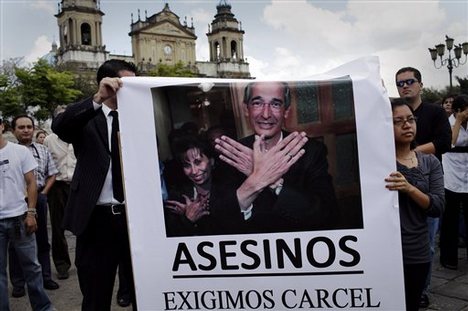 But what seemed was true was not. This case is a rare example where the truth actually came to the surface. Finding the truth serves to highlight just how concealed it is here. The UN’s International Commission against Impunity followed a winding trail of clues to discover that Rosenberg had set up his own murder so as to implicate the president, who he believed was responsible for the death of a murdered woman he had fallen in love with. He knew the legal system enough to know that the evidence he had to implicate the president for her murder would not stand up in court, so he gave his life hoping it would lead to what he believed was justice.
But what seemed was true was not. This case is a rare example where the truth actually came to the surface. Finding the truth serves to highlight just how concealed it is here. The UN’s International Commission against Impunity followed a winding trail of clues to discover that Rosenberg had set up his own murder so as to implicate the president, who he believed was responsible for the death of a murdered woman he had fallen in love with. He knew the legal system enough to know that the evidence he had to implicate the president for her murder would not stand up in court, so he gave his life hoping it would lead to what he believed was justice.
And that’s what happens in Guatemala. People agree on reality and it becomes reality. Corrupt politicians decide reality and it becomes reality. Unfaithful spouses decide reality and it becomes reality. An attorney seeking justice gave his life to coax the world into believing a lie that he thought would deliver justice.
The truth will set you free, says the famous Bible verse. But historically in Guatemala, the truth will get you killed. Whistle blowers get their heads blown off. In a country where for less than $100 you can order a stabbing, it’s best to keep your mouth shut.
“Luke, you can end the story anyway you want it to end it,” my dad said. And so this story ends in doubt. People tell themselves whatever convenient fiction they need to, reality be damned. I want to end this story with the truth, but I can’t. All I can tell you is that for some reason, unknown to me, they took the lion away and that surely somebody, somewhere, really knows why.

About the Author
 Luke Maguire Armstrong lives in Guatemala directing the humanitarian aid organization, Nuestros Ahijados. His book of poetry, iPoems for the Dolphins to Click Home About (available for sale on Amazon.com) is especially enjoyed by people who “don’t read poetry.” (@lukespartacus)
Luke Maguire Armstrong lives in Guatemala directing the humanitarian aid organization, Nuestros Ahijados. His book of poetry, iPoems for the Dolphins to Click Home About (available for sale on Amazon.com) is especially enjoyed by people who “don’t read poetry.” (@lukespartacus)
The post Why They Took The Lion appeared first on The Expeditioner Travel Site.
]]>The post Lions, CouchSurfing And Murder: On The Perpetual Strangeness Of Existence appeared first on The Expeditioner Travel Site.
]]>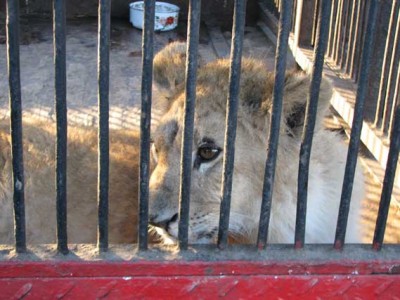
If I were superstitious, I might have seen the lion as a sign that in an hour-and-a-half I was going to be kidnapped or murdered. From the back of my motorcycle my roommate McKenzie pointed and exclaimed, “Dude, there is lion just sitting in a cage in that vacant lot. A lion!”
I just shrugged and glanced at the lion and said without emotion, “Welcome to Guatemala.” According to the Lukester Dictionary, “Welcome to Guatemala” is defined as: “An exclamation used in response to seemingly inexplicable occurrences frequently happening in Guatemala.”
As an example:
Guatemalan Tourist: Dude, they lost my luggage in Guatemala City’s airport and when they finally returned it, all my stuff was gone and the suitcase was filled with mangos and the The Book of Mormon.
Guatemalan Expat: Welcome to Guatemala!
The lone lion in a cage probably only meant that the circus was back in town and they had decided to park their lion in the vacant lot by my house. If it was true, it was a dangerous day to be a street dog.
Warning! Dog lovers, do not read the next paragraph.
If you have ever seen a circus in this part of the world, it is best described as a combination between animal torture and a cheap burlesque show. The last time the circus came to Antigua, Guatemala, the circus operators were offering $2 for every street dog brought to them. This was the most economical way to feed lions and tigers and bears. Yes, PETA, “Oh my!”
But back to my story. If I were superstitious, I would most certainly have seen the lion caged by my house as a sign not to show up for my 9:30 a.m. meeting. The night before I received a mysterious call from an unknown number. It was from a woman with a Russian accent calling herself “Alla.”
“Is this Luke ?” she had asked. I told her it was and in a pleading voice she implored, “Can I meet you first thing tomorrow morning?”
“Umm, who is this?” I asked.
“This is Alla . . . it is very important that I meet with you. I need some advice. This may seem strange, but all will become clear after our meeting tomorrow. Can you meet me at 8 a.m.?”
My interest was pricked. I told her I had work engagements until 9:30 a.m. This flustered her. Without hiding her agitation she retorted, “So you cannot meet me at 8 a.m.? Very well. At 9:30 a.m. I see you in front of the Jungle Party (a well known Antigua hostel).”
After I hung up my phone I replayed the conversation in my mind, trying to remember whether this same thing had occurred as part of the plot of a James Bond movie. Her Russian accent made it seem all the more ominous.

I couldn’t really imagine what this woman would want with me. Since my work in anti-human trafficking efforts causes me to work against some very bad people, I thought there was a slight chance this could all be a ploy to kidnap or murder me. So slight a chance I decided to still go to this mysterious rendezvous, but still likely enough that I asked a friend to drive there before me to act as a lookout should something shady happen. The caged lion next to my house that morning only added to the perpetual strangeness of my existence.
Despite the buildup, I’m obligated to say that I was neither kidnapped nor murdered. Though my inner idiot thought that it might be fun to be kidnapped, no attempt was made (yes, I did watch a lot of Bond as a kid).
As it turned out, Alla had gotten my telephone number from CouchSurfing. She was not Russian, but from Belarus. She had been traveling with a Russian woman and that woman’s boyfriend. From what she recounted to me, it seemed the female half of her travel companions had a borderline personality disorder. Alla told me about how she had been traveling with the couple and that the woman’s wild mood swings had eventually led to her being dumped off in Antigua while the pair of crazies took the rent-a-car to what had been their mutual destination of Copan, Honduras.
Basically, Alla just needed a reality check — someone to hear her out and agree with her that this Russian woman indeed was a psychopath. I bought her a coffee and listened to her tale. She was still shaken by the incident and I did my best to give her some perspective on it. I told her that in a few hours a shuttle would be going to Coban, so she could still make it there before needing to catch a flight home later in the week. She asked if she could store her luggage in my house and I told her that would be fine.
As I left the coffee shop — heading back to work to deal with a particular human trafficking case — I couldn’t help but feel caught in the middle of some divinely wonderful conspiracy. I am an avid fiction reader, but truth is certainly stranger than fiction.
To some the world can be a boring place of routines. But to others it can be a chaotic mess of unexpected awesomeness. All of this depends on where we position ourselves on the road of life. To take the metaphor further, I recommend to my fellow travelers that we position ourselves on a busy interstate lane where lions show up some mornings and mysterious phone calls cause our cell phones to shake and light up. When translated, “Welcome to Guatemala” can sometimes come off as, “Welcome to Peru. Welcome to Bulgaria. Welcome to Georgia. Welcome to Slovakia. Welcome to the Maldives. Welcome to Funky Town. Welcome to Iceland. Basically, welcome to the world and all of its discoverable strangeness.”
It all reminds me of the letter Benjamin Button wrote in Fitzgerald’s short story, “You can change or stay the same, there are no rules to this thing. We can make the best or the worst of it. I hope you make the best of it. And I hope you see things that startle you. I hope you feel things you never felt before. I hope you meet people with a different point of view. I hope you live a life you’re proud of. If you find that you’re not, I hope you have the strength to start all over again.”

About the Author
 Luke Maguire Armstrong lives in Guatemala directing the humanitarian aid organization, Nuestros Ahijados. His book of poetry, iPoems for the Dolphins to Click Home About (available for sale on Amazon.com) is especially enjoyed by people who “don’t read poetry.” (@lukespartacus)
Luke Maguire Armstrong lives in Guatemala directing the humanitarian aid organization, Nuestros Ahijados. His book of poetry, iPoems for the Dolphins to Click Home About (available for sale on Amazon.com) is especially enjoyed by people who “don’t read poetry.” (@lukespartacus)
The post Lions, CouchSurfing And Murder: On The Perpetual Strangeness Of Existence appeared first on The Expeditioner Travel Site.
]]>The post How I Taught Guatemalans To Stop Worrying About Kama Sutra And Love Yoga appeared first on The Expeditioner Travel Site.
]]>
“Come join us for yoga after work,” we would often ask them. We being gringos. They being Guatemalans.
At the educational development organization I work for in Guatemala, we have both local Guatemalans and international volunteers on staff. Since one of our international volunteers was a yoga instructor in a previous stateside life, we began offering weekly yoga classes at the end of the work day. Attendance was good, but always international. Always only international. Not one of the eighty Guatemalans staff members ever showed up.
It started to seem like the elitist gringo people´s yoga club. Despite the invitations to “Come join us for yoga!!!” the Guatemalans would only give us awkward smiles and give us a noncommittal, “Vamos a ver.” But whenever we vamos´d-a-ver´d we never ver´d any Guatemalan in the class.
We knew we could not force the Guatemalans into downward facing dog, so after work we merely donned our yoga attire and headed to the yoga room as the Guatemalans cast us awkward, shameful glances.
Finally, we got to the bottom their reluctance to Yoga. One of our long-term volunteers, sick of being a yoga elitist was talking to a group of our social workers. “Why don´t you come to Yoga ever?” She asked them. The social workers laughed uncomfortably and shook their heads. “You know,” she said, “Lots of athletes use Yoga to help them in sports,” she said, hoping their love of soccer (ahem, football) would make headway.
One of the social workers smirked at another and timidly joked, “Yeah, and I bet your wife would love all the new positions you´ll learn there.”
Suddenly it all made sense. The volunteer realized why the Guatemalans were so reluctant to come to Yoga. “You know,” she said “That Kama Sutra and yoga are not the same thing?”
The blank stares indicated that they had not known they were different things. So while we saw ourselves as innocently changing into sweats and caring mats under are arms to stretch our bodies and calm our minds, what the Guatemalans saw is that a bunch of gringos changing into comfortable sex clothes so that they could lock themselves in a room for an hour and practice different sex poses — not something anyone wanted to do with their coworkers after a hard day´s work (I´m not speaking for myself here).
With the newfound revelation that yoga is not Kama Sutra, yoga attendance is going through the roof, and cultural understanding is at an all-time high. As is usually the case when two cultures just don´t get what is going on with the other, there is some misunderstanding lurking beneath the surface.
In the case of yoga, the Guatemalans were sexualizing yoga in a way that had not been done since my ninth-grade gym teacher tried to teach us yoga until our raging hormones and sex jokes caused him to withdraw it from the curriculum. In this case, the Guatemalans learned that there´s nothing wrong with a little downward-facing-dog, and we learned the true meaning of Namaste.

About the Author
 Luke Maguire Armstrong lives in Guatemala directing the humanitarian aid organization, Nuestros Ahijados. His book of poetry, iPoems for the Dolphins to Click Home About (available for sale on Amazon.com) is especially enjoyed by people who “don’t read poetry.” (@lukespartacus)
Luke Maguire Armstrong lives in Guatemala directing the humanitarian aid organization, Nuestros Ahijados. His book of poetry, iPoems for the Dolphins to Click Home About (available for sale on Amazon.com) is especially enjoyed by people who “don’t read poetry.” (@lukespartacus)
The post How I Taught Guatemalans To Stop Worrying About Kama Sutra And Love Yoga appeared first on The Expeditioner Travel Site.
]]>The post Licking Like A Local In Antigua, Guatemala (Ice Cream, That Is) appeared first on The Expeditioner Travel Site.
]]>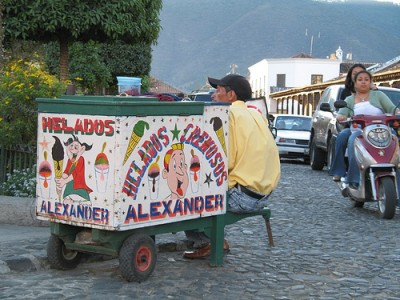
Guatemalans love ice cream. Well, at least in Antigua they do. At every turn, the historic city’s cobblestone streets seem to be crawling with people licking drippy cones of sugary frozen cream topped with a dollop of syrupy strawberry goodness. And it made me want it — like really want it — all the time.
The ice cream obsession became similar to my crazy cravings for coffee, and it had the same effect. Normally, if I were to see someone cradling a steamy cup of Joe, I would immediately feel the addiction tick go off in my head and, at that point, there would be no turning back: I would have to, somehow, get my hands on a vanilla soy latte. So, when I was taunted with swarms of people buying, selling, sharing and licking — always licking — ice cream, well, I had to get in on the licking party too. So I ate ice cream — a lot of it — and from almost every vendor and shop in Antigua.
And there were many shops and cart vendors to choose from, all located in walking distance of Parque Central. My top favorite vendors (in no particular order) were: Pida Sus Helados Cremosas, Super Esmeralda Helados, Saborealo Helados Chonita, and Deliciosos HeladoEmanuel. Each rolling cart produced the same sugary vanilla ice cream plopped on a cone and smeared with strawberry syrup, and all for the fine price of 1 Quetzal (or about the nice round price of $0.14). Although almost identical in appearance, the taste did differ from cart to cart. My favorite of favorites was Super Esmeralda Helados because it didn’t have an overwhelming frozen yogurt taste nor did it have a grainy texture like some of the others I sampled.
Helados Sarita and Helados Marco Polo seemed to be the two most popular ice cream shops in Antigua. They were set up more like your traditional mom-and-pop shops here in the States, complete with a toppings station and flavors display window.
All the ice cream eating was going just fine until I started to feel some uncomfortable rumbling in my stomach. As time passed the rumbling turned to pain, then the pain turned to nausea, and, well, you can probably figure out the rest. I began to wonder if I had gone overboard with the ice cream eating, but I rationalized that my consumption had been no more than what I would normally eat in an average week during the summer. No, there had to be more to what was going on. So I did what any savvy traveler would do — I turned to Google.
It didn’t take long to find the warnings. Almost every blog and informational website that mentioned ice cream and Antigua suggested that visitors should avoid eating from the carts on the streets as the sanitary conditions were “unregulated” and “unknown.” So there I was, a supposed seasoned traveler, who always prided herself on knowing the “what to avoid” stuff, sick from the mounds of “unsanitary” ice cream I had obsessively shoveled into my mouth.
So the moral to the story here? Lick like the locals in moderation and do it inside, ideally in the confines of a mom-and-pop shop.
[Photo by Antiguadailyphoto.com/Flickr]
By Maria Russo

About the Author
 Maria Russo is a freelance writer who loves natural wonders, good eats, ethical travel, and boutique hotels. Her work has appeared on the Huffington Post, USA Today.com, People.com and A Luxury Travel Blog, among others.
Maria Russo is a freelance writer who loves natural wonders, good eats, ethical travel, and boutique hotels. Her work has appeared on the Huffington Post, USA Today.com, People.com and A Luxury Travel Blog, among others.
When Maria is not writing for her all-time favorite site (that would be The Expeditioner), she spends her time blogging about foreign jaunts and delectable food experiences for her site: Memoirs of a Travel & Food Addict. She is also up to no good on Twitter (@traveladdictgrl, @expedmaria).
The post Licking Like A Local In Antigua, Guatemala (Ice Cream, That Is) appeared first on The Expeditioner Travel Site.
]]>The post An Open Letter To The Guatemalans Setting Off Fireworks Outside My Door Every Morning At 4 A.M. appeared first on The Expeditioner Travel Site.
]]>
Guatemala has a loud tradition of setting off firecrackers early in the morning to celebrate a birthday. Contributor Luke Maguire Armstrong has a tradition of sleeping in the early-morning hours.
Dear Firecracker-Loving Guatemalans,
Let me begin by assuring you that I am no hater of firecrackers. When I was a young boy I fondly remember how I waited longingly for the Fourth of July. I would gleefully spend the paper route money I had been saving all summer on as many fireworks as my demurring mother would allow. Julys in my childhood were generally filled with joyous days spent seeding ant hills with little bombs. (Ants, I’m sorry. I was young. I’ve changed. Please stop living in my kitchen.)
So, it’s not that I hate fireworks. I just feel all good things should be enjoyed in moderation. The beauty of our Independence Day is that it comes only once a year. It does not come every morning at 4 a.m. Your tradition of waking up a family member celebrating a birthday by creating a war zone-like atmosphere seems to me to be at times a little loco. It actually seems a lot loco. It seems locisimo. Frankly, no one wants to be woken up to the sounds of World War II outside their bedroom.
I like to sleep. And I have trouble believing that I have a neighbor with a birthday every morning. Because it does seems like every morning bombs are bursting. Who are you people? Who are these people who are setting alarms every morning at 4a.m. to light off firecrackers? If you’re an early riser, fine, but please allow us with normal hours the pleasure of sleep.
I remember the incident when the firecrackers sounded so close that it felt like someone had set fireworks off inside my house. Imagine my surprise when I looked and saw that, yes, someone had indeed thrown a string of firecrackers into my open window. I am still not sure what message was being communicated by this action. It made me feel not so welcome in your country and I consider myself a good neighbor. Case in point is that I am one of the few people in the neighborhood who does not urinate on other people’s homes. I also remind you that if you read the package firecrackers come in, it is clearly indicated that they are not to be used indoors.
And to the person who threw a string of firecrackers at my motorcycle as it drove past a crowd, you got me. You can now go brag to your friends about how you scared the living shitepokes* out of the gringo.
In conclusion, and in the spirit of cultural understanding, I will not ask that you stop enjoying firecrackers all together. But I would appreciate it if you stopped throwing them into my window. And I would like to recommend investing some of the money set aside for firecrackers on other things such as food for the millions of starving children here.
Muchas gracias,
The Gringo
*shitepoke- |? sh ?t?p?k |noun informal, any of a number of birds of the heron family.

About the Author
 Luke Maguire Armstrong lives in Guatemala directing the humanitarian aid organization, Nuestros Ahijados. His book of poetry, iPoems for the Dolphins to Click Home About (available for sale on Amazon.com) is especially enjoyed by people who “don’t read poetry.” (@lukespartacus)
Luke Maguire Armstrong lives in Guatemala directing the humanitarian aid organization, Nuestros Ahijados. His book of poetry, iPoems for the Dolphins to Click Home About (available for sale on Amazon.com) is especially enjoyed by people who “don’t read poetry.” (@lukespartacus)
The post An Open Letter To The Guatemalans Setting Off Fireworks Outside My Door Every Morning At 4 A.M. appeared first on The Expeditioner Travel Site.
]]>